-

2020-11-16
This is a meme of Grogu (baby Yoda), created by Indigenous Rising Media, advising Indigenous communities to wear their masks properly in order to protect their elders.
-
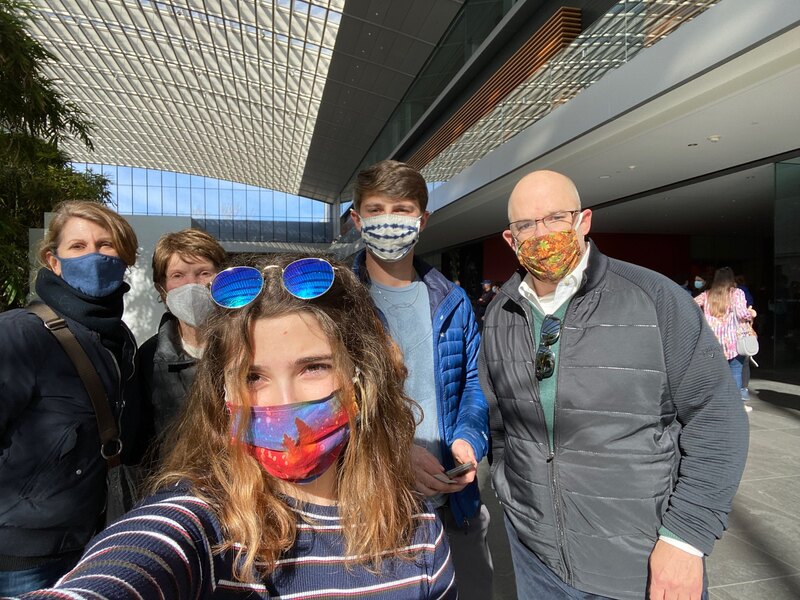
2021-03-13
There's not much to tell, everyone in this photo (besides my brother, in the white a blue mask) already had COVID but we still wore our masks knowing there's still the possibility of spreading the virus.
-

2021-04-01
San Deigo County has issued reopening guidelines for theatres. This marks the first time the theatres will be able to reopen in over a year. However, with the new guidelines theatres fear being accused of privacy violations.
-
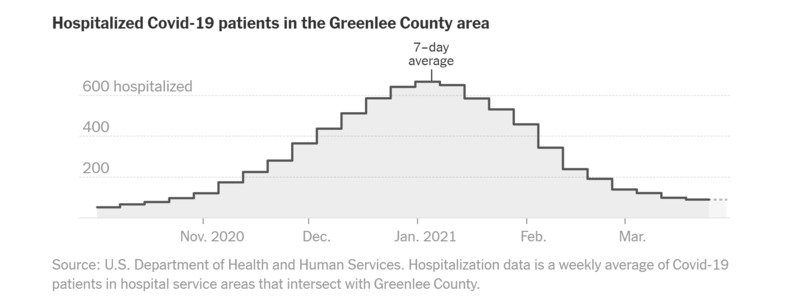
2021-03-30
This daily tracker displayed on the New York Times site displays and explains public data provided by the Arizona Department of Health Services. The attached graphs illustrate the disparate COVID-19 experience between Arizona residents in Maricopa County and Greenlee County.
Arizona is the sixth largest of the United States with a population of more than seven million residents within its 113,594.08 square miles. 61% of Arizonans reside in Maricopa County, which translates to a population density of approximately 481.3 people per square mile, or 57,959.3 square feet per resident. In contrast, southeastern Arizona’s Greenlee County claims only 0.14% of the state’s residents for a population density of 5.7, or approximately 4.8M square feet per person.
-

2021-03-31
This is an oral history of Chris M. Monaghan, an artist based in Dexter Michigan, conducted by Monica Ruth, a graduate student intern with the COVID-19 archive, A Journal of the Plague Year. Chris talks about his street art/chalk artwork, participating in chalk art festivals, how the pandemic has influenced the festival and artist scenes, the sense of community in chalk art, and how chalk art is a source of entertainment, hope, and outlet for mental and physical health.
-
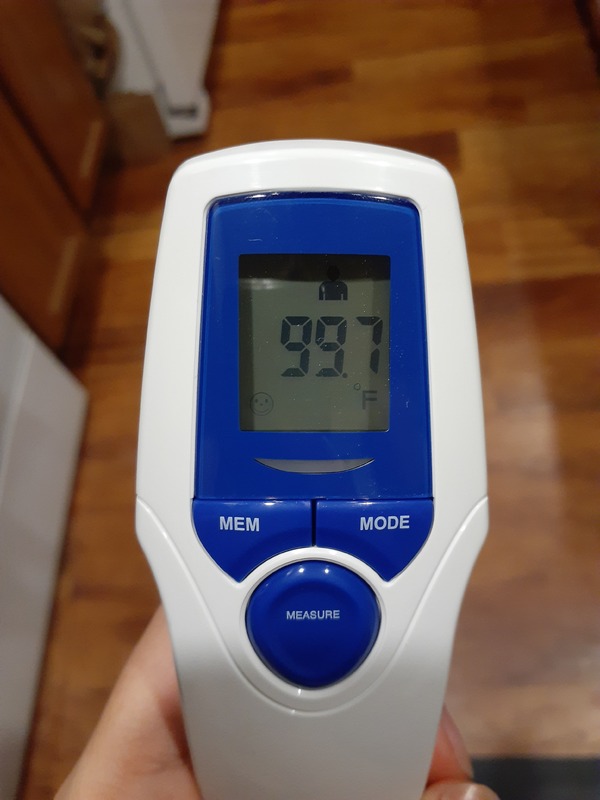
2021-03-31
Didn't realize there was such a wide market of thermometers until I needed to purchase one during this pandemic. Picked this one up at my local Fry's for forty dollars.
-
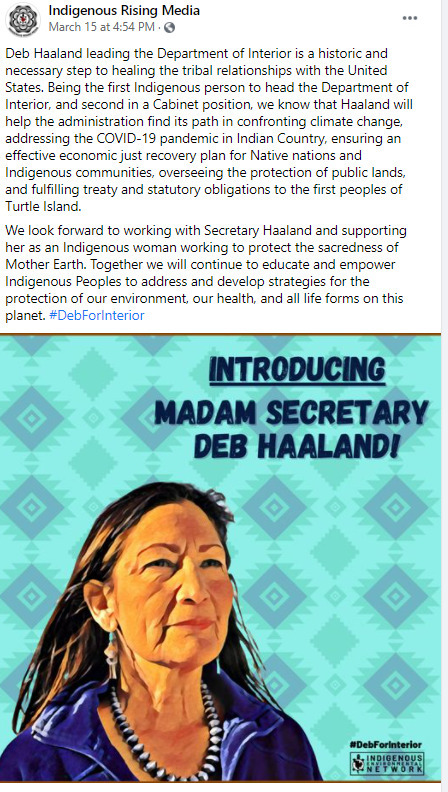
2021-03-31
Deb Haaland made history as the first Indigenous woman to head the Department of Interior. This is a watershed moment as this department is responsible for the managing the relationship between the Indigenous Peoples and the United States. Haaland is a Laguna Pueblo from New Mexico.
-

2021-03-31
This link is a podcast with which talks about a specific family of 4, including 2 girls ages 5 and 7 and the two guardians who have health witnessed changes in their children's behavior due to covid. It is a very interesting read and listen as both the children now have been hearing things about deaths due to covid and because of that say things such as "I don't care if I die". The read goes on to state some factual information, some important things said include, " a sex-abuse hotline operated by the Rape, Abuse & Incest National Network reported that half its calls in March came from minors, for the first time in its history." This was somthing that I heard for the first time and was shaken. Not only are children going through the stress of their own during the pandemic but they stay home and are potentially being abused. For some children going to school was an escape. I was though was very happy that these minors had information on who to contact for help.
-
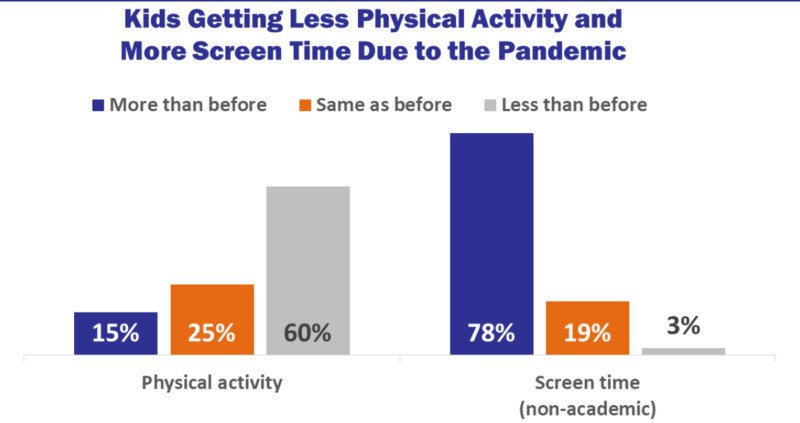
2021-03-31
This link talks about the effects the pandemic has on children's nutritional health and physical activity. With parents already being stressed about managing through the pandemic, the quality of care for children had gone down. According to this site "Families report that during COVID-19 mitigation, time spent in physical activity and sports has decreased while sleep time and screen time have increased." It is understandable that this is an issue as children are limited from going outside as families fear for their health along with the lack of social life has caused children to sleep and use electronics more as a sense of coping from boredom. Not only is this affecting children now but will affect the future of these children as these will become habits, and habits are something that is hard to grow out of when they are developed since childhood.
-
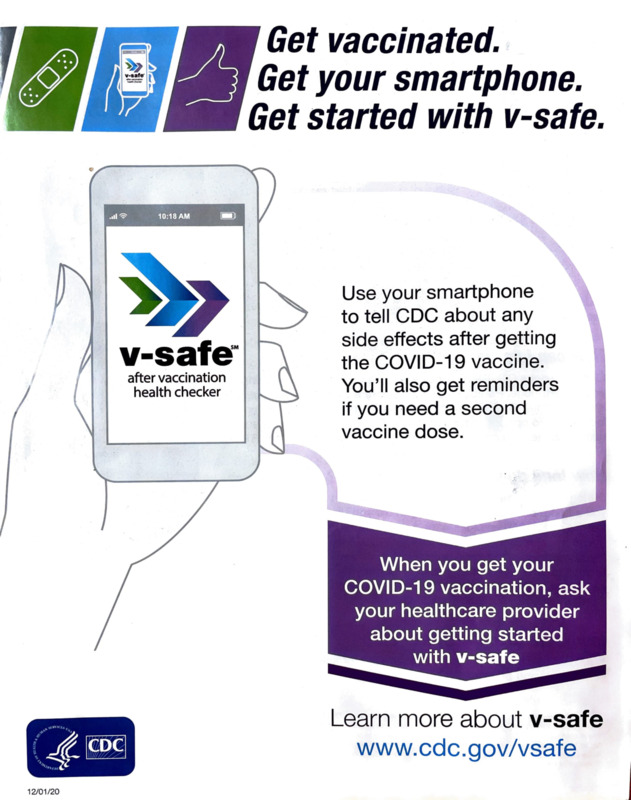
2021-03-19
After receiving the first dose of the Moderna vaccine, the volunteers at ASU handed out these booklets with information about the Moderna vaccines. It lets you know that no vaccine is FDA approved and that you should report any symptoms to the CDC using the vaccine safe program with your smartphone.
-

2021-03-31
This is a mural painted by Indigenous artist, Ivan Lee.
-
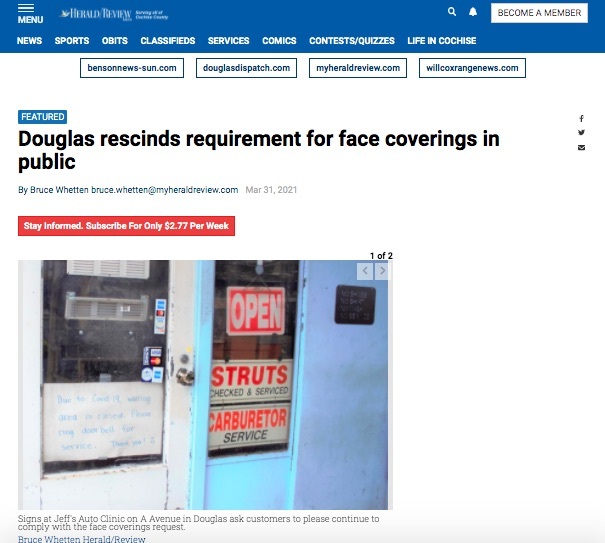
2021-03-31
This news story relays a decision by municipal leadership in Douglas, Arizona, to rescind their mask mandates following Governor Ducey's similar order on 25-March-2021.
-

2020-05-11
The Alpenhorn Man statue, affectionately known as "Alpine Al", has welcomed visitors to Smithers, British Columbia since 1979. The statue sits at the intersection of Highway 16 and Main Street, the entry point to the heart of downtown Smithers. Since the beginning of the Covid-19 pandemic in March 2020, the statue has been "masked" several times by anonymous local residents, in the hope of generating a smile or two - a rare case of Covid humour?
-
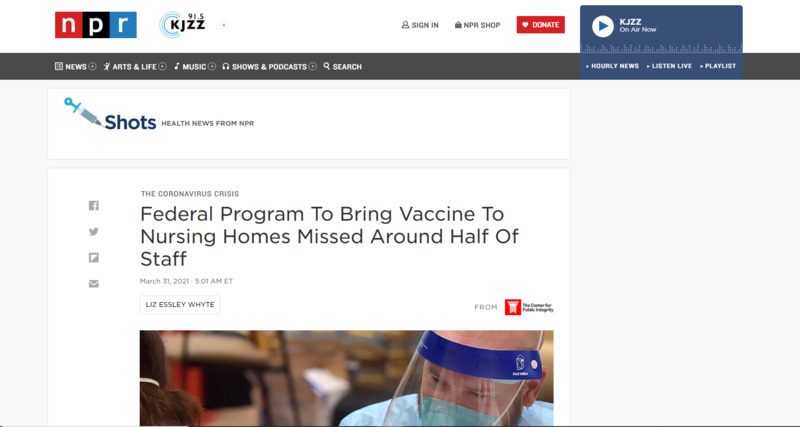
2021-03-31
While the federal government put effort into getting residents and staff at nursing and retirement homes vaccinated, many remain unvaccinated. Some states even have less than a third percent of the staff vaccinated. This has impacted reopening timelines for the facilities and fears of spreading COVID-19.
-
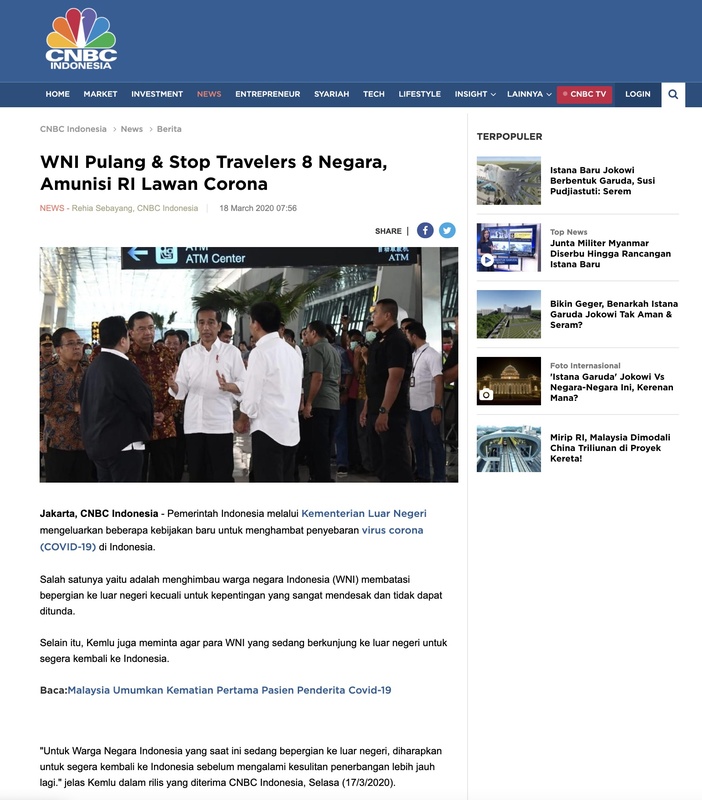
2021-03-18
This article shines some light on the travel restrictions in Indonesia at the moment. It reports that Indonesian citizens are urged to come back into the country if they are travelling abroad. This is to limit the distance, and to assure that citizens can come back before travel becomes more difficult. However, they listed eight foreign countries (Iran, Italy, Vatican City, Spain, France, Germany, Switzerland and Great Britain) in which they would ban arrivals from. If any person had travel records that showed that they were in the listed countries in the past 14 days, they would be banned from entering the country.
This article was personally translated.
-
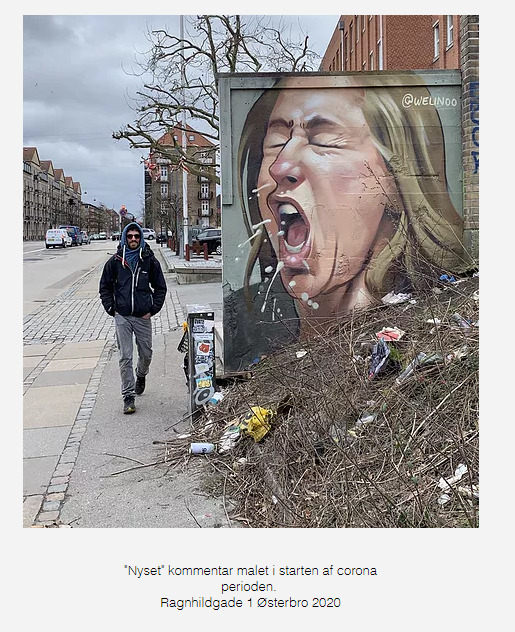
2020-03-22
Andreas Wellin is a street artist from Denmark, residing in Copenhagen. Some of his recent mural work includes images and themes from the pandemic, including a sneezing woman, and a surreal image of Donald Trump as a COVID-19 virus/Shrek figure. The Shrek-COVID-Trump image includes a caption on the corresponding Instagram post: "I take no responsibility for painting this piece," which is a direct reference to Trump's statement in March 2020 regarding the pandemic, "I don't take responsibility at all.”
-
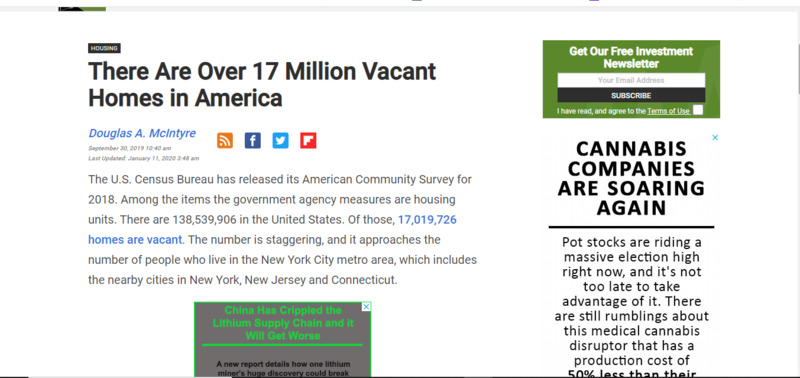
2019
This article reports that they are over 17 million empty homes in the United States which greatly outnumbers the amount of homeless people in the country. The article then goes on to describe the location and other demographics of where these homes are. I wanted to include this article because it shows that we have the resources for people to not be homeless during the pandemic but there seems to be no incentive or interest in addressing this problem. The number of homes is so much greater and it could greatly mitigate some of the health and exposure issues homeless populations experience. This will allow me to show how homeless people are traditionally not even considered in resources.
-
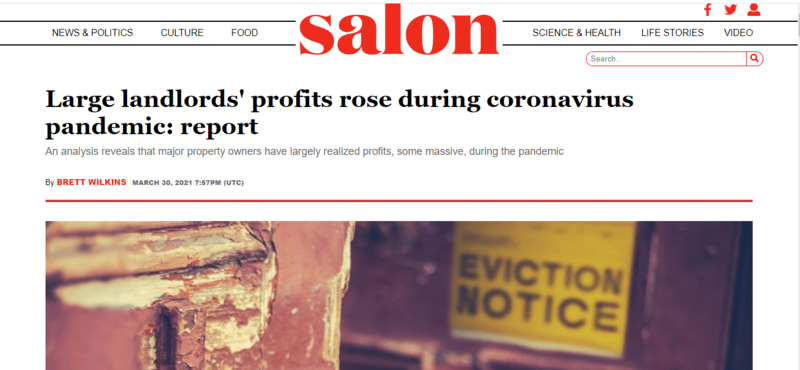
2021-03-30
This article discusses how despite initial assumptions that landlords may have been harmed during the Coronavirus they have actually been seeing large profits. Understanding that landlords are still earning money and turning a profit. This idea is in direct violation of the narrative that these eviction moratoriums are harmful to landlords. I wanted to include this article because I think to understand homelessness you also have to understand property ownership and landlording. I'll use the article to provide examples about how the homelessness experienced during the pandemic was preventable and how the pandemic has been kinder to landlords than to homeless people.
-
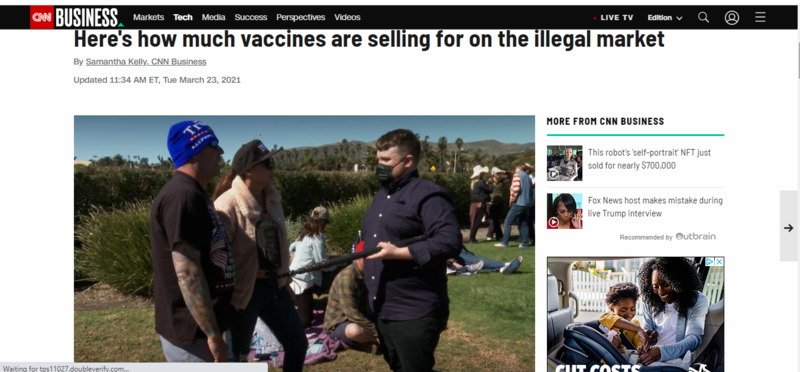
2021-03-23
This article relays data gleaned from cybersecurity firm Check Point Software to a CNN reporter, Samantha Kelly, related to the illicit market for COVID-19 vaccines and proof of vaccination cards available for purchase through the dark web.
-
2021-03-30
I hope I will be able to attend virtual school.
I hope I can visit my friends.
I hope my friends can visit me.
I hope we can eat at restaurants.
I hope the olympics will happen soon.
I hope I can travel all over the world again.
I hope we can go to amusement parks.
I hope I can make new friends.
I hope I don’t get lost on campus.
-
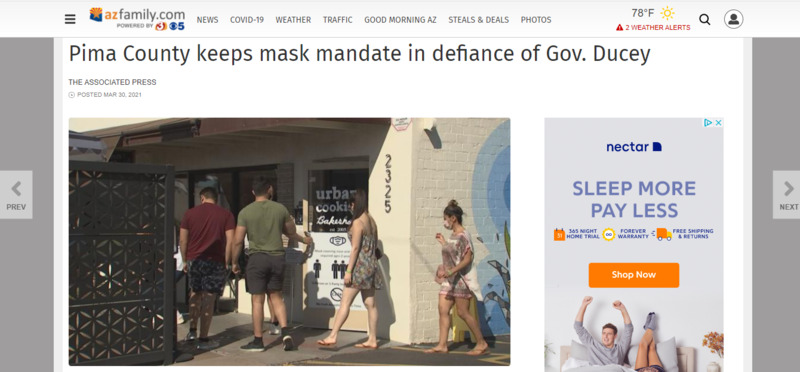
2021-03-30
This article from the Associated Press relays the arguments Pima County officials have made in keeping mask mandates in place despite recent orders from Governor Doug Ducey on 25-March-2021 that prohibit new mask requirements and phase out current restrictions previously issued by local governments across Arizona.
-
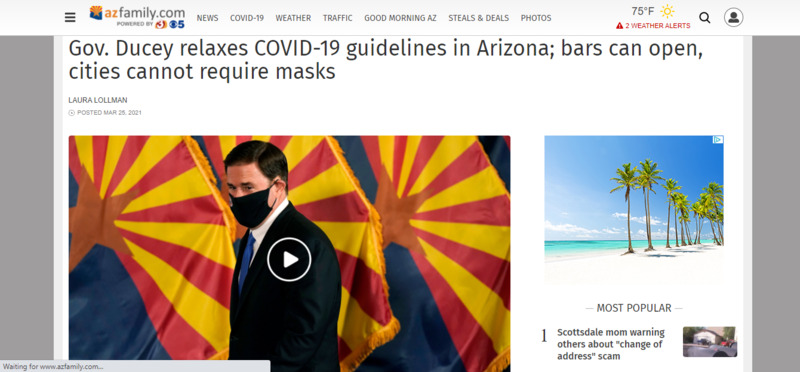
2021-03-25
This news article from Laura Lollman of 3TV/CBS5 in Phoenix, Arizona, relays updated COVID-19 guidelines that Gov. Doug Ducey signed into place on March 25, 2021. These included a statewide phase-out of municipal and county mask mandates and prohibitions on new mask mandates; businesses may continue to require patrons and employees to use masks or face coverings; gatherings of more than 50 people no longer require permission from local governments; bars may fully open and choose to require patrons and employees to wear masks and social distance
-
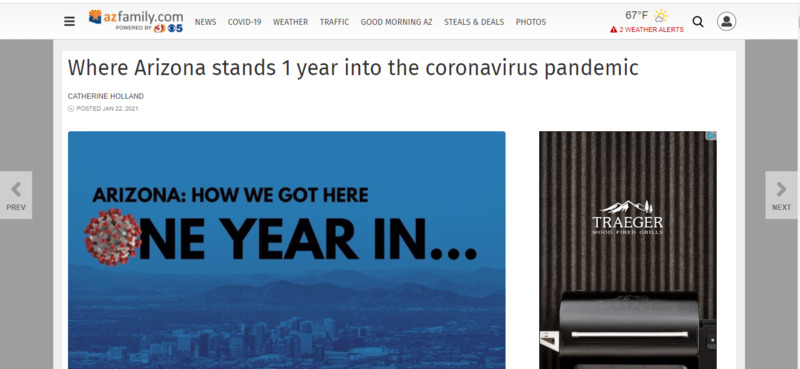
2021-01-11
This online news article from Catherine Holland of 3TV/CBS5 in Phoenix, Arizona, relays her assessment of key highlights in Arizona's pandemic history from the first anniversary of SARS-CoV-2's confirmed presence in Arizona on January 11, 2020.
-
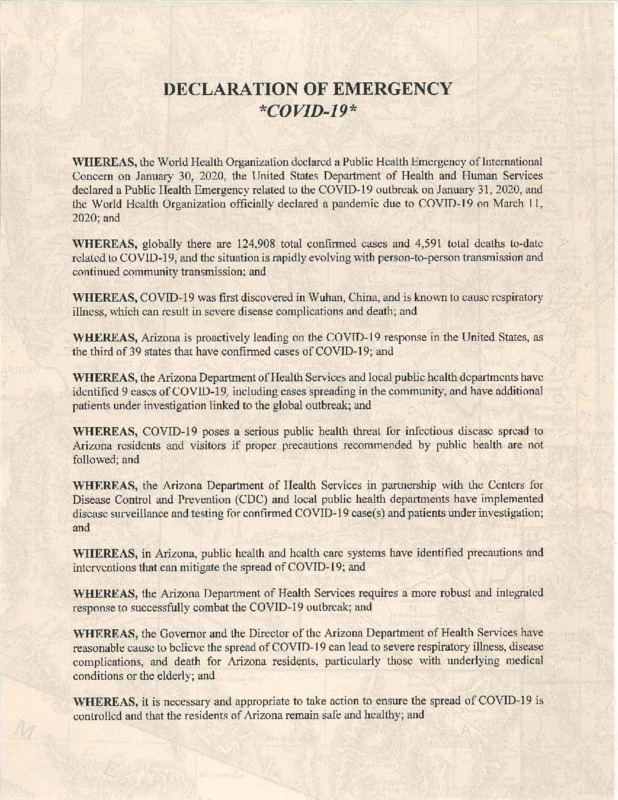
2020-03-11
Declaration of Emergency - COVID-19
WHEREAS, the World Health Organization declared a Public Health Emergency of International Concern on January 30, 2020, the United States Department of Health and Human Services declared a Public Health Emergency related to the COVID-19 outbreak on January 31, 2020, and the World Health Organization officially declared a pandemic due to COVID-19 on March 11, 2020; and
WHEREAS, globally there are 124,908 total confirmed cases and 4,591 total deaths to-date related to COVID-19, and the situation is rapidly evolving with person-to-person transmission and continued community transmission; and
WHEREAS, COVID-19 was first discovered in Wuhan, China, and is known to cause respiratory illness, which can result in severe disease complications and death; and
WHEREAS, Arizona is proactively leading on the COVID-19 response in the United States, as the third of 39 states that have confirmed cases of COVID-19; and
WHEREAS, the Arizona Department of Health Services and local public health departments have identified 9 cases of CO VID-19, including cases spreading in the community, and have additional patients under investigation linked to the global outbreak; and
WHEREAS, COVID-19 poses a serious public health threat for infectious disease spread to Arizona residents and visitors if proper precautions recommended by public health are not followed; and
WHEREAS, the Arizona Department of Health Services in partnership with the Centers for Disease Control and Prevention (CDC) and local public health departments have implemented disease surveillance and testing for confirmed COVID-19 case(s) and patients under investigation; and
WHEREAS, in Arizona, public health and health care systems have identified precautions and interventions that can mitigate the spread of COVID-19; and
WHEREAS, the Arizona Department of Health Services requires a more robust and integrated response to successfully combat the COVID-19 outbreak; and
WHEREAS, the Governor and the Director of the Arizona Department of Health Services have reasonable cause to believe the spread of COVID-19 can lead to severe respiratory illness, disease complications, and death for Arizona residents, particularly those with underlying medical conditions or the elderly; and
WHEREAS, it is necessary and appropriate to take action to ensure the spread of COVID-19 is controlled and that the residents of Arizona remain safe and healthy; and
WHEREAS, the Governor is authorized to declare an emergency pursuant to A.R.S. § 26-303(D) and in accordance with A.R.S. § 26-301(15).
WHEREAS, pursuant to A.R.S. § 26-307(A), a state agency, when designated by the Governor, may make, amend and rescind orders, rules and regulations necessary for emergency functions;
WHEREAS, pursuant to A.R.S. § 36-787(A), during a state of emergency declared by the Governor as a result of an occurrence or imminent threat of illness or health condition caused by an epidemic that poses a substantial risk of a significant number of human fatalities or incidents of permanent or long-term disability, the Arizona Department of Health Services shall coordinate all matters pertaining to the public health emergency response of the State; and
WHEREAS, pursuant to A.R.S. § 36-787(B) and (C), during a state of emergency declared by the Governor, the Governor, in consultation with the Director of the Arizona Department of Health Services, may issue orders pertaining to the public health emergency response of the State; and
WHEREAS, pursuant A.R.S. § § 36-788 and 36-789, during a state of emergency declared by the Governor, the Arizona Department of Health Services, to protect the public health, may establish and maintain places of isolation and quarantine and require the isolation or quarantine of any person who has contracted or been exposed to a highly contagious and fatal disease;
WHEREAS, the Legislature has authorized the expenditure of funds in an event of an emergency pursuant to A.R.S. § 35-192; and
WHEREAS, Executive Order 2017-06 establishes the Arizona Emergency Response and Recovery Plan to assist in responding to emergencies including public health emergencies; and
NOW, THEREFORE I, Douglas A. Ducey, Governor of the State of Arizona, by virtue of the authority vested in me by the Constitution and Laws of the State, do hereby determine that the COVID-19 outbreak presents conditions in Arizona, which are or are likely to be beyond the control of the services, personnel, equipment, and facilities of any single county, city or town, and which require the combined efforts of the State and the political subdivision, and thus justifies a declaration of a State of Emergency; accordingly, pursuant to A.R.S. §§ 26-303(0) and 36-787, I do hereby:
a. Declare that a State of Emergency exists in Arizona due to the COVID-19 outbreak, effective March 11, 2020; and
b. Direct that the State of Arizona Emergency Response and Recovery Plan be used, and the Division of Emergency Management to be engaged, as necessary or requested, to assist the Arizona Department of Health Services' coordination of the public health emergency response and authorize the use of state assets as necessary; and
c. Authorize the Director of the Arizona Department of Health Services to coordinate all matters pertaining to the public health emergency response of the State in accordance with A.R.S. Title 36, Chapter 6, Article 9;
This Emergency Declaration will be eligible for termination upon the resolution of the outbreak as determined by the Arizona Department of Health Services.
IN WITNESS WHEREOF, I have hereunto set my hand and caused to be affixed the Great Seal. of the State of Arizona.
ATTEST:
GOVERNOR (Douglas Ducey)
DONE at the Capitol in Phoenix on this 11th day of March in the Year Two Thousand Twenty and of the Independence of the United States of America the Year Two Hundred and Forty-Fourth.
ATTEST:
Secretary of State (Katie Hobbs)
-
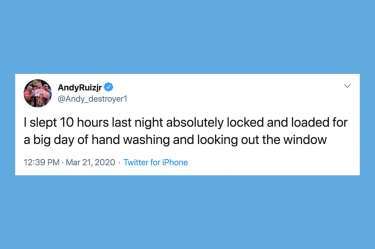
2020-03-21
I found this tweet to be funny and also interesting as people look back on COVID as it has been over a year since it started. Many people, myself included, were not doing much of anything in the end of March 2020 except for following all the simple rules put out there to keep people from spreading the disease, like you hear when you're 5 (don't put your hands in your mouth, wash your hands, etc). This tweet reminded me of how far we have come from when we were not able to do simple activities we had always done like go to school and work and how people's actions have changed over time, even when the pandemic was still present.
-
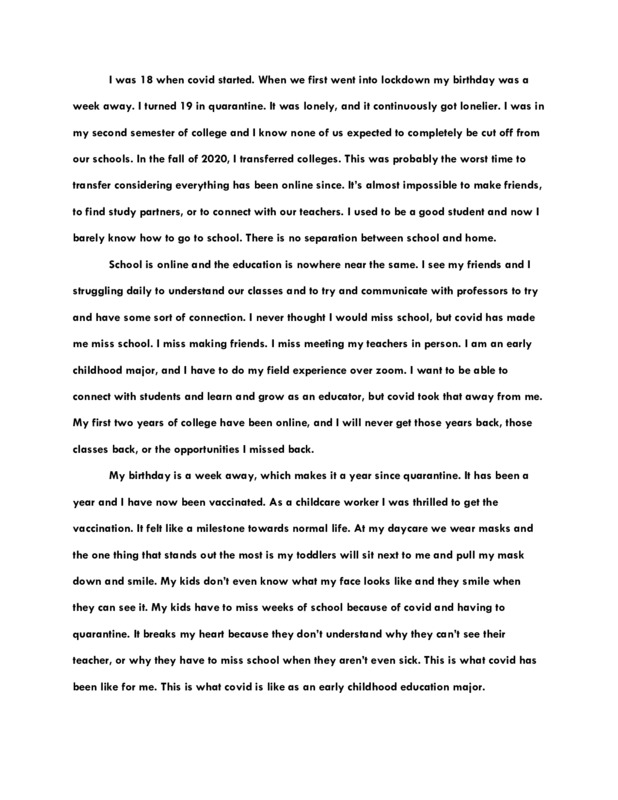
2020-04-02
I wrote about my story through covid. I am a college student studying Early childhood education. I am also a child care worker. My submission is about what it was like going through college during covid. This is important to me because it's my experience and I know many other college students feel the same way.
-

2020-11-21
Despite the pandemic and all it entailed, I was able to meet my current boyfriend and fall in love. He has made this uncertain time, incredibly better.
-
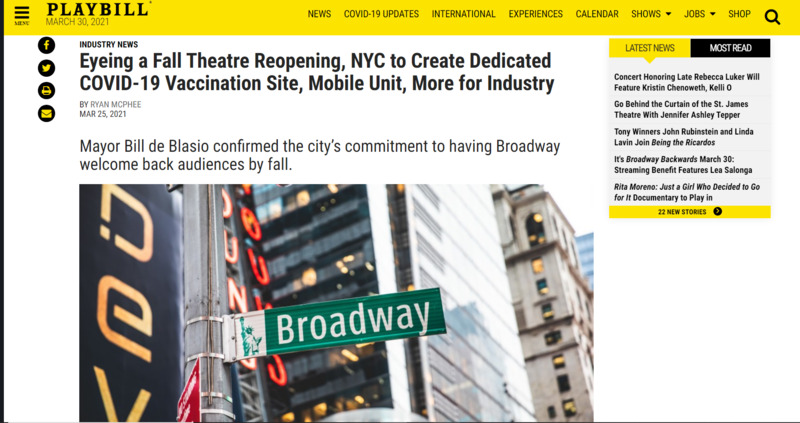
2021-03-25
Mayor Bill de Blasio of New York has announced efforts to reopen Broadway by the fall. These efforts include vaccine and pop-up testing sites in the theatre district. Currently, no performance will take place at least through May 30. However, pop-up performances and performances at certain venues are still happening.
-

2021-03-29
This is a 40-minute video that documents, in an entertaining manner, a couple and their cat going on a road trip across the United States during the pandemic (New Years 2020-2021). They began their journey from their house in Los Angeles, California towards their destination of Philadelphia, Pennsylvania in a matter of 6 days (3000 miles). They shared their experience going state to state, along with the precautions they took while doing so. As the title of the video suggests, “We Moved Across The Country,” they did end up moving to North Carolina. So this video covers what road travel was like as well as moving during the pandemic.
-

2021-03-29
This March 29, 2021, episode of The Daily Chirp podcast from the Douglas Herald discusses Bisbee Mayor Ken Budge's recent retraction of mask mandates in that community
-
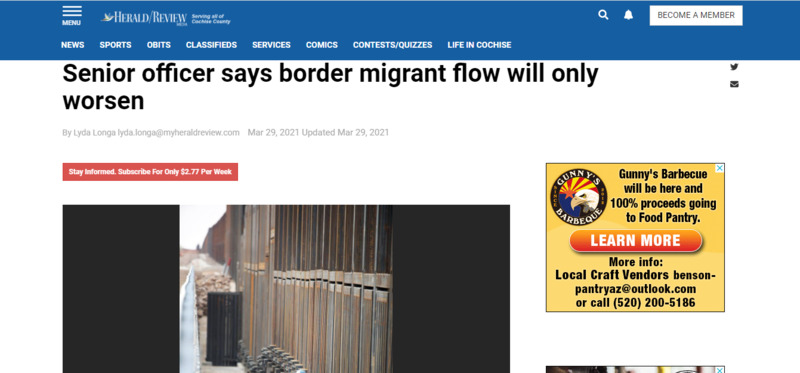
2021-03-29
"Senior officer says border migrant flow will only worsen"
By Lyda Longa, lyda.longa@myheraldreview.com, Mar 29, 2021
The situation with undocumented migrants flocking to the Southwest border of the United States from Mexico is only going to worsen, a senior Border Patrol agent warned Friday.
The agent, who spoke to various media outlets during a conference call, said at least 380,000 undocumented people had been apprehended at the Southwest border in February and the numbers would be higher for March and beyond.
The agent spoke on background with the agreement that media would not reveal his name.
“I fully expect to see the numbers increase as we go into the summer months,” the senior agent said, concerning migrant crossings.
In Cochise County that warning has begun to bear out near Douglas and in Willcox, where the already stretched-thin Border Patrol is arresting more single adults attempting to slip into the country or taking in and processing children who are flocking to the border unaccompanied.
Douglas Mayor Donald Huish said Friday the latest information he received this week from Border Patrol agents at the station just outside Douglas is that they’re confronting and repatriating about 100 single adults daily who are trying to slip in illegally.
“They are getting closer and closer to town,” Huish said.
What concerns Huish even more is that Border Patrol agents from the Douglas station are being pulled out to help in busier areas such as Yuma and Tucson.
“They’re siphoning them off to the western part of the state and leaving us with a skeleton crew,” Huish said.
In Willcox, Mayor Mike Laws said he was told two weeks ago by the Border Patrol there were 54 unaccompanied children at the Border Patrol station.
“That was two weeks go. Who knows now?” Laws said. “The station can only hold up to 81.”
Laws said he was told by Border Patrol that a “third party” has been arriving at the facility and taking 10 to 20 children to Phoenix by via bus. The mayor said he does not know how often the transportation comes or who the third party is.
“We have not seen anyone (undocumented migrants) running the streets so far,” Laws said. “All we have is the youths, but we don’t see them either.”
Laws and Sierra Vista Mayor Rick Mueller said citizens in their respective communities would gladly help the undocumented migrants but there aren’t enough resources available to do so. Laws, Mueller and other mayors in Cochise County signed a letter recently asking the federal government for help with the matter.
Last week, the town of Gila Bend, which has a population of about 2,000, declared an emergency after Border Patrol agents dropped off a group of migrant families with children in a park.
Gila Bend Mayor Chris Riggs told reporters he and his wife ended up using loaned vans to drive the families to the Phoenix Welcome Center so they would have a safe place to stay. Riggs said Border Patrol agents told him to expect more of the same.
Mueller said there have been no such issues in Sierra Vista, but he is worried that the municipality, if hit with something similar to what happened in Gila Bend, would have no resources to offer.
Last week Arizona senators Kyrsten Synema and Mark Kelly announced they’ve been pushing for more federal resources to help Arizona cities with a sudden influx of undocumented migrants. The senators helped secure at least $110 million from the Federal Emergency Management Agency as reimbursement to cities that assist migrants left within their jurisdictions.
Also last week, Arizona Gov. Doug Ducey and Florida Senator Rick Scott — who sits on the Homeland Security Committee — called on President Joe Biden and Department of Homeland Security Secretary Alejandro Mayorkas to visit the Southwest border. Ducey and Scott, accompanied by a handful of law enforcement and other elected officials, had toured a portion of the border near Douglas.
At his first press conference on Thursday since taking office in January, Biden said he would come to the border soon, but thought a visit now would deflect attention from the issue at hand.
The senior Border Patrol agent who spoke Friday, meanwhile, said 300 Border Patrol agents who work along the northern border of the U.S. have been “mandated” to the Southwest border to assist with the influx of migrants.
He said about 2,000 family units out of the 6,000 who are trying to cross daily are being processed in Texas by the Border Patrol. The agent revealed that unaccompanied children are being kept in Border Patrol facilities longer than the 72 hours established by law because too many are showing up and agents are overwhelmed.
“They’re keeping them a few days, sometimes up to a week,” the senior agent said.
Once an unaccompanied child is encountered, Border Patrol contacts the Department of Health and Human Services. The latter makes arrangements for the migrant children to be taken by the Office of Refugee Resettlement.
The agent also mentioned an increase in the criminal element among undocumented migrants.
“The threats we see are significant,” the senior agent said. “We have seen criminal (undocumented migrants).”
Additionally, he said that COVID testing for migrants is only being done in facilities in Del Rio, Texas, and soon in the Rio Grande Valley in Texas. Other than that, testing is being undertaken by non-governmental agencies that are helping the migrants and U.S. Immigrations and Customs Enforcement officials.
He said it was probable that some migrants with COVID-19 may have been released into communities.
-
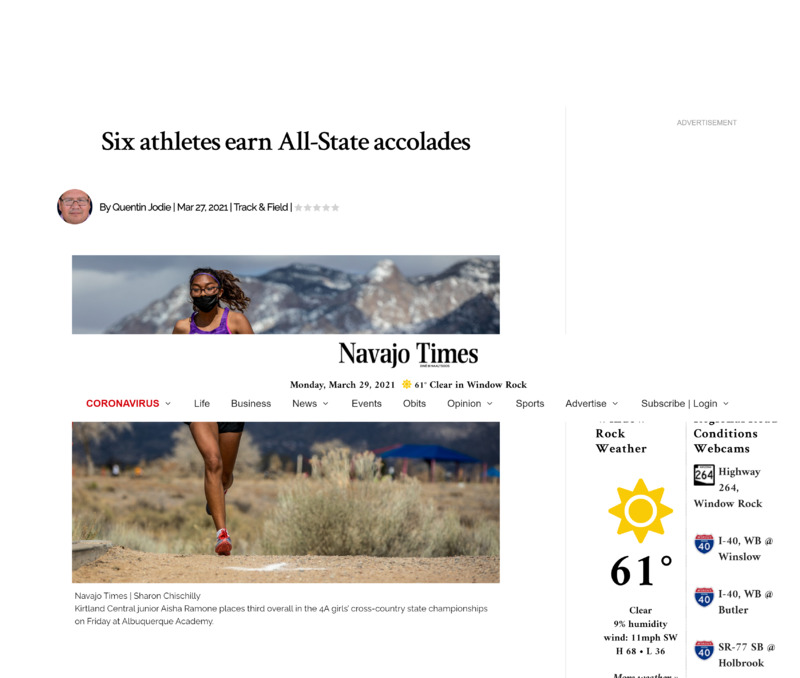
2021-03-27
By Quentin Jodie | Mar 27, 2021 | Track & Field |
Navajo Times | Sharon Chischilly
Kirtland Central junior Aisha Ramone places third overall in the 4A girls’ cross-country state championships on Friday at Albuquerque Academy.
ALBUQUERQUE
It’s been a long time coming for the Tohatchi boys’ cross-country team.
On Friday, the Cougars placed four runners in the top 20 at the New Mexico Class 3A state cross-country meet as they secured the second-place trophy.
“It’s been a while since we took one of these home,” Tohatchi coach Fern Spencer said of the red trophy.
The longtime coach is not sure when was the last time they brought home a state trophy in cross-country but she said it was well deserved.
“It’s very good for the program,” she said when asked if the state runner-up trophy is a nice addition to the trophy case. “They’re all young so we have another year with them. We’re going to continue to work hard and keep improving.”
The Cougars were not the only school to take home hardware as six athletes earned All-State honors.
In the 4A girls’ race, Kirtland Central’s Aisha Ramone and Shiprock’s Kaydence Platero placed third and fourth, respectively.
“Finishing in the top three was my main goal and I got it,” Ramone said, who finished the 5K race in 19:47.77. “I just felt like I could have stayed up with the Albuquerque Academy runner (Emma Patton) but I just didn’t dig deep down enough to finish second.”
Nonetheless, the KC runner was happy that she improved from last season’s sixth place finish at state.
Platero was another runner who saw improvements from last year as she jumped four spots to fourth this year.
“I’m so happy that I made the top five,” Platero said. “This is a big morale boost for me because I didn’t have a lot of confidence in myself but my team, my coach and the whole town of Shiprock cheered me on.”
Platero, who was clocked in at 20:00.26, said her game plan worked to near perfection as she tried to shadow Ramone.
“I tried to hang with Aisha and I tried to execute that but they did take off,” she said. “But in the end I was still able to finish behind them.”
With a team score of 83 points, the Aztec Lady Tigers placed fourth while Shiprock took fifth with 94 points.
In the 4A boys, Miyamura’s Tayan Benson made the podium with a 10th place finish.
“I was hoping to do better than last year, but I just couldn’t do that today,” the Miyamura junior said.
In the team standings, the Shiprock Chieftains placed fourth while Miyamura took sixth.
In the 3A boys’ race, Albuquerque Cottonwood Classical ran away with the state title with 14 points while the Cougars finished with 47 points.
Tohatchi was led by Nicolas Yazzie as he placed 10th overall.
“It means a lot to us,” Yazzie said. “We all come in every day to practice and we give it our all. It just led to this moment and I think the time and effort we put into this paid off. I couldn’t have done it without them.”
In addition to Yazzie, the Cougars had Melvin Scott Jr. place 14th, Jimmie Chavez III 17th and Jared Peterson 20th to complete the team score. Tohatchi’s fifth runner, Rodney Joe placed 30th overall.
Individually, Crownpoint’s Tylon Tsosie and Newcomb’s Damien Johnson were named to the 3A All-State team by placing in the top 10. Tsosie took seventh, one spot ahead of Johnson.
In the 1A/2A meet, the Ramah girls and Rehoboth boys took fifth in their respective races.
-
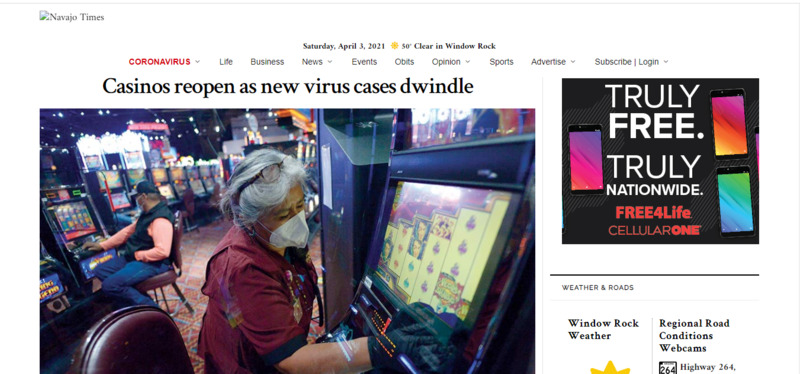
2021-03-25
By Donovan Quintero | Mar 25, 2021 | Business, CORONAVIRUS |
CHURCH ROCK, N.M.
Peterson Zah has a concern.
On Tuesday, while hundreds of Fire Rock Casino patrons tried to win some money, the former Navajo Nation president wanted to hear what the COVID-19 public service announcement sounded like in Navajo.
“I didn’t hear any of the PSA while inside because it’s so noisy,” he said.
After taking a step outside the casino, the former Navajo Nation president said he was able to hear it. But that raised a concern for him.
“And it’s pretty good,” Zah said, explaining the PSA in Navajo was clear and concise. “But you can only hear that clear outside and inside you can’t really understand it.”
Zah said he was concerned no one would hear the COVID-19 safety guidelines everyone needed to follow. His other concern was that since many Navajo people have gotten both doses of the vaccines, many of them might become emboldened.
“The reason why I was concerned is people have this attitude that because of the shots … they say, ‘Hey, I’m immune, I don’t have to worry about the virus.’ So when I go places I’m gonna take mine (mask) off,”’ Zah said Tuesday.
According to the president’s office, more than 76,000 people have been fully vaccinated as of March 23 and more than 191,000 total doses have been administered.
Zah didn’t think people should take any chances by easing up on protecting themselves from the contagious respiratory virus because some people were not wearing masks.
After being closed for more than a year, Fire Rock Casino and Northern Edge Casino were on the fifth day of a two-week “soft reopening.”
Just the gambling portion of the casinos were open at 25% capacity, and only Navajo Nation residents were allowed into the casinos, according to Navajo Gaming interim CEO Brian D. Parrish.
Parrish clarified Navajo Nation residents meant everyone, including non-Natives, living on the reservation would have access to the casinos during the reopening phase.
“We’re doing it with a two-phase reopening plan that started with Fire Rock and Northern Edge first,” he said. “We’re going to reevaluate with the Navajo Nation. They’re going to do audits and monitor our implementation of our workplace safety plan.”
Of the 1,180 casino employees, 650 have returned to work since last Friday, said Parrish.
Employees like Fire Rock Casino housekeeper Mildred Russell, who said she’s been out of work for over a year, were happy to be working again.
“It’s been a struggle,” Russell said while cleaning a slot machine last Friday. “Hopefully this pandemic will be gone and everybody can go back to their normal lives.”
Other employees, like casino security officer Vernon Keeswood from Hogback, New Mexico, shared Russell’s gratitude for getting the call to go back to work.
“It’s good,” he said on Tuesday during a telephone interview that was arranged by Michele J. Crank, executive director of communications and public relations for Navajo Nation Gaming Enterprise.
Instead of the usual hugs and shaking hands, Keeswood said, now it was “fist bumps” and “elbow bumps.”
As for the reopening, he said many Northern Edge Casino customers “are pleased and happy” the Navajo casinos have begun reopening. He added a few customers were not sure if the casinos should reopen.
“I hope everyone washes their hands and practices social distancing so we open to 100 percent capacity,” Keeswood said. “I hope it opens more.”
After all, the threat of another COVID-19 outbreak looms on everyone’s mind, including that of Robert Peterson from Thoreau.
“People are still afraid to come here but a lot of them want to enjoy being out instead of being stuck at home,” said Peterson, who said he lives alone, last Friday.
Peterson said being alone and dealing with the pandemic has been hard for him. Despite his fears, he decided to head to Fire Rock to get his mind off COVID-19.
Mary E. Silversmith, 79, from Lupton, Arizona, ensured no one came to visit her with a “no visitors allowed” sign posted on her hogan. She was happy to support the casino employees who returned to work.
“The casinos were opened for the casino employees,” she said on Tuesday at Fire Rock. “Many of have children and they have bills to pay.
“Because of that, I am OK with the reopening,” she said. “Some people have been criticizing the reopening. Not me, I don’t think that way or talk that way.”
Before the pandemic, Silversmith said she frequently ate at Fire Rock, as well as at Twin Arrows Casino and Resort, when she had extra money to spend.
Silversmith was wearing a surgical mask.
To gain entry into both casinos during the soft reopening, a state ID, like a driver’s license, is required and a working number at which customers can be contacted.
Temperature checks were also part of the requirements for anyone wanting to enter.
After their temperature was checked, security asked customers to momentarily remove their masks and look at the front entrance security camera.
The purpose of collecting all of the information is for contact tracing, said Parrish.
“We have an excellent plan that’s in place,” he said. “We’ve had it reviewed and modified and enhanced by public health experts, not only on Navajo, but outside the Navajo Nation.”
He added that Navajo Gaming invested close to $2 million in “equipment, supplies, signage, training,” to keep everybody safe.
U.S. Indian Health Service officials toured both of the casinos’ kitchens on March 12, Parrish added, to review their safety procedures.
“And in terms of reopening of the other properties, especially at a higher capacity percentage, that’s going to be based not only on how well the enterprise does, but what’s happening with the public health metrics, the rate of vaccinations on Navajo and other key indicators like that,” the interim CEO said.
The Navajo Gaming enterprise’s careful planning even got praise from Jordan Schermerhorn, a senior research associate at Georgetown Center for Global Health Science and Security.
Schermerhorn stated in an email to NNGE their plan showed the tribe was leading “the entire country in a smart, careful return to normalcy.”
“Combined with the Navajo Nation’s outstanding vaccine rollout, this soft reopening shows what is possible with a data-driven pandemic response in a community dedicated to public safety,” Schermerhorn‘s email said.
Even the ventilation, air conditioning and heating systems, which completely re-circulate the air inside the casinos 15 times a day, were reviewed, said Parrish.
“We’re ready to go to fifty percent, we’re ready to offer food and we’re ready to bring the rest of our team back,” Parrish said.
Zah watched casino patrons trying to win money as sounds from the Tuesday afternoon hustle and bustle all but drowned out the COVID-19 PSA.
“So basically, the attitude shouldn’t be such now that because they got their shot they don’t have to worry about it,” he said. “It’s still around. Even though ninety percent of the people may be wearing their mask, or all of them, if one of them comes in that has it, then we’re in trouble.”
Zah explained a new COVID-19 variant is much smaller than the original strain, which to him was why everyone needed to double mask.
“If you can see light through your mask that means it’s gonna go through,” Zah said. “We gotta start wearing two masks.”
He said he intends to go on KTNN and remind everyone not to run off to Phoenix or Albuquerque just because they’ve been vaccinated.
“At the same time, they still have to follow those protocols,” he said. “I want to say, ‘You gotta start wearing double masks.’”
As of Tuesday night, the Navajo Nation Department of Health reported a cumulative 30,010 cases of the virus and 1,233 deaths.
-
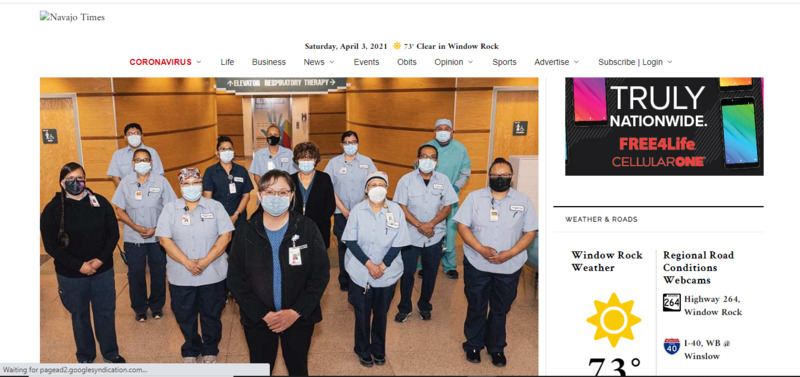
2021-03-26
By Rima Krisst | Mar 26, 2021 | CORONAVIRUS, People |
Tséhootsooí Medical Center workers share experiences
Wilberta “Billy” Jackson, public health nurse III
This pandemic has been the longest roller coaster of stress, grief, and loss. I’ve kept my routine simple – sleep, eat, and exercise. And, more sleep.
This has been and will probably be the most challenging time of our lives. I could focus on all the bad, but so much good has come from this, from community members stepping up, leaders rolling their sleeves up and getting dirty, how we came together to care for our elders, and so much more.
Professionally, we’ve adjusted and readjusted a million times over and completely changed how we deliver health care. We’ve had information, guidance, and policies being added or changing every day and we still were able to deliver health care in a safe, efficient manner.
At the beginning of the pandemic, our leaders were warning everyone about the health care system being overwhelmed. Most people thought about it in terms of hospitals running out of beds, but they didn’t think of it in terms of how an underfunded and shorthanded public health force would respond to a pandemic in a rural area with limited resources, and where a population’s most basic physiological and safety needs are not being met.
When you don’t have access to clean water, food, shelter and security, you’re not able to prioritize prevention measures until your basic human needs are addressed.
The resiliency of the Diné people is unrivaled.
The days I’m struggling or feel like giving up, I hear my grandmother’s words, and that’s what keeps me going. And my mother’s surprise delivery of Navajo soul food meals.
I’m a public health nurse, so it won’t come as a surprise that I’m excited about the COVID vaccines. We’ve already seen a substantial decline in cases, hospitalizations, and deaths, so we know it’s working.
My hope is that our response to the next pandemic or health care crisis won’t be complicated by politics, lack of national strategy, lack of preparation, and misinformation.
Stacey Burnside, Primary Care registered nurse
What I have learned from this pandemic is to cherish every day and every person that you love.
COVID-19 has impacted my family and me profoundly. I lost an uncle and an aunt to COVID-19, and to this day, it is surreal that they are gone.
As a primary care nurse, it is difficult to hear about losing a patient to COVID-19, and at the peak, it was almost a daily occurrence…
The challenges that I faced during this pandemic were adapting to the changes in work roles and being separated from the people I love. The clinic that I worked in was closed when the pandemic hit the first peak, and I, along with my coworkers, was informed that we had to work in the Emergency Room.
The moment that I saw a patient who needed me to be their nurse, despite having COVID-19, humbled me. That moment in the ER humanized COVID-19 for me and made me realize that I was put there for a reason. No matter what the situation is, nurses adapt, and the teamwork and strength we draw upon each other are phenomenal.
A huge hit to me personally and professionally was losing a friend to suicide … dealing with grief, loss, and stress has been a daily thing.
What has helped me is drawing strength from my God, husband and son, and family. There are many negatives to the pandemic, but one positive that many have seen is the love and strength we have found among our families.
I am thrilled that we are at a point of a high vaccination rate in the Navajo Nation. I remember when I administered my first COVID-19 vaccine to a patient, it brought tears to my eyes, and I cried after work.
Leah Chattin, respiratory therapist
I’ve been a respiratory therapist since 2003. What I experienced throughout the first surge of COVID-19 here on Dinetah is not what you prepare for.
I see the impact on my life as deep internal scars that I buried and to resurface those experiences is a nightmare. Imagine the inability to fully take a deep breath, something so simple we take for granted.
Supporting my patients with breathing treatments, providing chest physical therapy, changing breathing devices constantly because the demand for oxygen escalates all in a 12-hour or more shift.
All these specialized techniques to avoid the last option of intubation, allowing an artificial airway introduced to your trachea with an opening at the tip to provide mechanical breaths from a mechanical ventilator.
Fear expressed from my patients was a frequent emotion. You are alone, isolated from your family, your loved ones, no familiar face to embrace, to celebrate your improvement or the worst, a decline despite the battle you have endured. I’d remind my patients not to give up…
Instinct took over because I’m a mother too, a nurturer. I can remember softly stroking their hair, holding their hands, shedding tears, praying, putting myself in that empty place at bedside where your family should be gathered, processing the grief. Accepting loss was tremendously difficult.
I lost myself because I did not decompress my emotions. My spirit slivered away slowly each time my patients faced rejection of our efforts to sustain life.
How I endured and sustained my sanity was prayer requests. Prayer was undoubtedly my saving grace.
This virus is fluidic, the path it took was unpredictable. I strongly believe we need to continue wearing a mask, following the CDC guidelines and begin or sustain our health and wellness. Putting into words my experience was not an easy effort, however it’s a pathway for healing. Every COVID patient I battled for will forever have a place in my heart.
Sandra Fouser, nurse executive of the Primary Care and Specialty Clinics
Seeing the virus cross the ocean and hit the heart of the Navajo Reservation forever changed our lives. As a health professional, I knew venturing into the unknown with limited protection meant some would survive and some wouldn’t.
What I have learned working on the front lines – compassion, cohesiveness, companionship, strength, sadness and mental stress. We have been battered, beaten, praised, comforted and have also received recognition from all walks of life.
I am proud to be a nurse.
I believe the strength to endure comes from resiliency and the people we work with and the support of our families at home. As nurses, we cannot stand still. I feel it is in our blood to help and move forward.
I have lost friends, coworkers, relatives and patients. The grief I feel is palpable, almost more than I can handle. Seeing my family, staff and patients suffer through illness and grief has been very challenging and heartbreaking.
As a team, I believe when something happens to one of us, we all feel the effects, we grow closer and find comfort in each other.
I see the vaccine as a progression toward eradicating the detrimental effects of this virus and giving us hope that there is a better tomorrow and that Hózhó will be restored.
Dr. Karen Williams, hospitalist physician
I am a Native physician (Mountain Maidu/Apache) and Indian Health Service Professional Scholar.
When the pandemic started our hospitals were suddenly overwhelmed with large numbers of very ill patients needing oxygen. Some patients who worsened were placed on a “life support” or ventilators since they could no longer breathe on their own.
Despite our best medical management efforts, including use of high-flow oxygen, there were patients who did not survive.
I witnessed more death in a year than I have ever experienced in my career. This was traumatic for me because every day I came to work I felt like I was coming into a war zone.
We saw people struggling to breathe and fighting for their life. We heard family members saying their goodbyes to their loved ones and crying over the phone. We held hands of those who took their last breath and witnessed co-workers not able to control their tears.
If it were not for our team efforts, almost a military-style mentality, we could not have managed.
As a hospitalist physician, the biggest challenge was ensuring that I had the most up-to-date medical knowledge to save a patient’s life. During the beginning of the pandemic many doctors throughout the country did not feel prepared. This was quickly overcome by learning medical strategies used by doctors throughout the world.
The treatments used included steroids, anticoagulant medications, and high-flow oxygen. We had the support of our hospital’s incident command leadership and adapted to the changes. This included being able to offer our patients who needed oxygen a federal Drug Administration-approved “emergency use” medication called Remdesivir, and more recently Bamlavinimab for non-hospitalized patients
My experiences on the front lines were psychologically and physically overwhelming … I sought support from elders and used my Native spirituality for strength. I also sought protection support from traditional Indian practitioners who set up a tipi and hogan outside the hospital for employees.
I sometimes thought twice about the danger I was in. However, I acknowledged that I would never walk away. This is a result of my obligation to the Native community and the hundreds of patients I had gotten to know for so long. I “warriored up” in my mind and sought to do the best I could.
I do not foresee an end to mask wearing, and now recognize how careful we all must be to protect each other. I saw too many elders get severely ill and even pass away from COVID as a result of young family members not being careful and bringing it home.
I have encouraged community members and my own family to get the vaccine as soon as possible. I received two doses of the Pfizer vaccine and said a prayer in my Native way each time for protection.
Natasha Topaha, certified medical assistant, Mobile Unit
Overall, this year has been extremely challenging, but also has reinforced my personal strength and resiliency. I have had ongoing concerns throughout the epidemic regarding my kids’ isolation and their mental health.
It has been difficult, but doable, to manage both working in health care and supporting my family both emotionally and physically. I had constant worry about bringing the virus home and infecting my family given that I was working in high risk areas and providing COVID testing, vaccines and social and mental health support to patients.
I found that doing outdoor activities with my family, such as bike riding and hiking, helped me ease my stress and helped teach my children some healthy coping skills. And we could spend time together!
I feel very happy and grateful in both receiving the vaccine and being able to provide it to patients and the community. I feel safer at work and at home now.
Johnny Willeto Jr., facility manager/logistics chief
The strength to endure comes from within yourself. For me this began in my childhood as the son of Delphine Damon Willeto and Johnny Willeto Sr., who nurtured me to become a great human being. They taught me to be a courageous, productive worker and know my limitations.
As a facilities manager, my main focus and responsibilities are the protection in the physical environment of all who walk through the doors of Fort Defiance Indian Health Board’s facilities.
All we knew is that COVID-19 was airborne and surface communicated. I treated it as you would tuberculosis and ensured that my staff had adequate PPE to help protect them when they are tasked with working in the patient care areas.
This responsibility was a big challenge when trying to procure medical equipment such as masks, gloves, safety glasses, gowns, scrubs, and so forth.
Having an MBA has allowed me to flourish in this high stress environment and to adjust with adaptations to finding supplies and creating new relationships with trustworthy suppliers.
Being in close proximity to patients who are struggling with getting well can be heart wrenching.
Being able to fulfill my duties in the support role to the best of my ability for my community and teammates has allowed me to sleep well at night knowing that I gave it my all.
I have lost a brother-in-law who contracted the virus in the Scottsdale area of Arizona.
These were very difficult times because as Navajos we are accustomed to comforting each other by a hug or handshake. With COVID, gatherings are not safe, so having family meetings for planning the funeral is off and also the funeral usually consists of 10 minutes before the burial with only a few close family in attendance.
One of the biggest assets I have gained is the spiritual belief in God and keeping the communication open by saying my prayers often – to be thankful for the blessings that have come my way or when asking for strength to endure the hardships.
In my free time I isolate on the Willeto Sheep Ranch in Goatsprings Valley, Arizona, where I tend 120 sheep and goats. Being able to separate the everyday stress and recharge is paramount to going forward with courage and mental sharpness to make the right choices for the organization, patients and employees.
The vaccines are an effective tool to help reduce the mortality of the virus on us and give us protection to this invisible enemy.
Corinne Legah, Environmental Service supervisor
Personally, I was scared when I first heard of the spread of the virus overseas. It was shocking how fast the virus traveled.
In the beginning our team was needed to help keep the hospital sanitized and safe for patients. We reinforced training on the cleaning process for the airborne/droplet virus. I constantly stressed wearing PPE and hand washing.
I am so proud of the team for stepping up by protecting our patients. They became warriors to fight the virus.
I believe without my husband’s support and God I would not have been able to cope. I have lost friends and family from this virus. It saddens me that many of our people are now in the spirit world.
Being a Native and growing up with Navajo beliefs, I had to be strong. My ancestors went through so much and our people are resilient. Prayer is our strength.
I cried when I watched the news when the vaccine was given to the first person in the U.S. If everyone gets their vaccine we will be able to interact with family again. I am looking forward to that day!
-
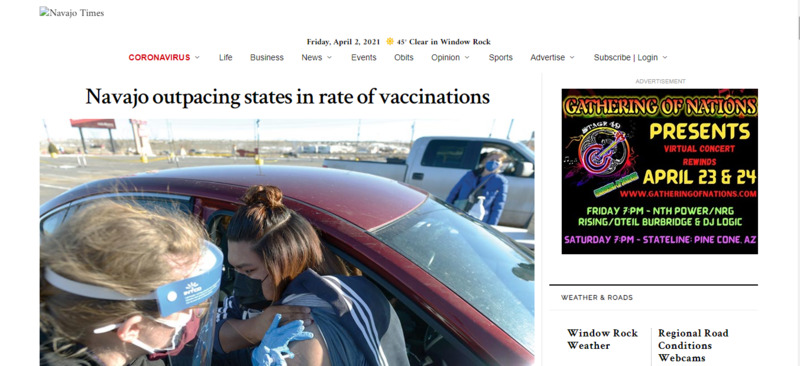
2021-03-09
By Rima Krisst | Mar 9, 2021 | CORONAVIRUS, News |
WINDOW ROCK
President Jonathan Nez proudly said last week that the Navajo Nation had exceeded its goal of administering 100,000 COVID-19 vaccine shots by end of February, crediting tireless health care workers who have been serving seven days a week to plan vaccinations and administer the vaccines.
On Tuesday, the president’s office reported that 135,161 COVID-19 vaccine shots have gone into arms on the Navajo Nation, which represents 92% of the total 146,980 doses received and includes 48,800 persons who have had their second shots.
This means that over 26% of the approximately 327,000 enrolled Navajos have gotten a shot through the Navajo Area Indian Health Service and tribal health care system, which is an amazing feat.
By comparison, in New Mexico 22.4% of the population (738,705) has been given at least one shot. Arizona has administered at least one shot to 17.1% of the population (1,847,750), with Utah trailing behind at 12.2% receiving at least one shot (687,925), according to the CDC data vaccine tracker.
And as of March 2, 15.3% of the U.S. population had received at least one shot, with 76.9 million shots administered, including 25.4 million receiving the second dose. Approximately 1.8 million vaccines per day are being administered daily in the U.S.
So, percentage-wise, Navajo is outpacing both neighboring states and the general U.S. population.
‘Amazing partnership’
On a Feb. 25 IHS media call, IHS Chief Medical Officer Rear Adm. Michael Toedt reported that as of Feb. 18 the IHS had also achieved its goal of administering 400,000 doses of COVID-19 vaccine “across IHS, tribal, and urban Indian Health programs,” representing 16% of the “target population,” with 6.3% receiving two doses.
“This milestone was reached ahead of schedule despite severe weather, making travel to health facilities difficult across much of Indian Country and leading to shipping delays,” said Toedt.
Toedt said most IHS facilities have now vaccinated the majority of their priority populations and are moving into Phase 2, which includes those who work in higher risk settings such as schools and prisons.
“Very shortly we expect that everyone who needs a vaccine will be able to receive it,” he said.
Toedt credited IHS and tribal health care employees across the country who are committed to ensuring the protection of tribal communities in 11 geographic areas covering 26 states and 349 health facilities, many in rural and remote locations.
“We have had an amazing partnership with our tribes to use all available resources to help with delivery of vaccine,” said Toedt.
This included distribution and redistribution of vaccines by ground and air transportation as needed.
Toedt said the IHS has also conducted over 2 million COVID-19 tests at a higher per capita than most states and is reporting a seven-day average test positivity rate of 4.5%, below the 5.6% all-races rate in the U.S., despite the fact that COVID-19 has had a disproportionate impact on American Indians/Alaska Natives.
The Navajo Nation has conducted 245,085 COVID-19 tests resulting in 29,774 positive cases.
‘Developing trust’
Coordinated public relations campaigns in partnership with tribes have been key to the success of the vaccine rollout, said Toedt.
Navajo Area IHS Chief Medical Officer Loretta Christensen agreed, saying public messaging has been critical.
“This collaboration is one of the reasons we’ve been extremely successful,” said Christensen. “Honesty and transparency, developing that trust with the people you are serving is vital. We have spent a great deal of time on that relationship with our Navajo people to encourage them to be vaccinated.”
She said the communication process has been very unified across Navajo and with the president’s office, using social media, radio, and a bilingual approach.
“This is constant public education,” she said. “We encourage people in a very personal way that we would like them to be safe, keep their families, their communities safe. We feel very fortunate and grateful that our population has really stepped up.”
Toedt acknowledged there has been some vaccine hesitancy relating to how quickly the vaccines were developed and whether or not they are completely safe, which has made some people distrustful.
According to IHS Public Affairs Specialist Joshua Barnett, a recent IHS-funded survey by the Urban Indian Health Institute reported that 75% of Native Americans were willing to get a vaccine and 74% believe that doing so is their responsibility to help protect their community.
“I’m confident that the process for vaccine development has the full integrity and completeness of time necessary to make sure these vaccines are safe, but it’s our job as healthcare providers to communicate that in a way that’s acceptable and trusted by our population,’ said Toedt. “We know our efforts are working and we’re seeing good delivery and acceptance of these vaccines in our communities.”
Reaching the homebound
Christensen said one of the strongest assets in the Navajo vaccination campaign has been the collaboration between public health nurses and community health representatives in reaching out to community members at the local level, including homebound elders and persons with disabilities.
“These are the people out in the rural areas that know the families, that know the homes,” said Christensen. “We rely on them for that person-to-person contact out in the communities.”
She said between 4,000 to 5,000 homebound individuals have actually been vaccinated at home or close to home.
Moving forward with the goal of getting the Navajo population vaccinated and achieving “community immunity,” Navajo Area IHS wants to make sure that all 27,000 square miles of the Nation have been penetrated, said Christensen.
“We want to be able to target any communities, populations or subgroups that have perhaps maybe not been able to get vaccinations,” she said. “So, our first step is to heat-map our whole area and then focus on those populations that are perhaps more rural or don’t have easy access to healthcare facilities.”
“Our goal is to get every single person vaccinated and to keep our populations in Arizona, New Mexico and Utah safe,” she said.
Christensen said her team will be working with chapters to identify anyone who might have been missed.
They have also reached out to Navajos living off reservation and have established an online registry to help people find a place to get their vaccination.
“We highly encourage them to come back if they need to and we will certainly take care of them and their families,” she said.
Tracking variants
In regard to surveillance for COVID-19 variants, Toedt said IHS does contribute its tests to state public health labs as well as different large lab corporations such as TriCore, LabCorp. and additional processes for genomic testing are in development.
“The samples that are included through those mechanisms are sampled through the CDC’s processes to test for genomics,” said Toedt.
Christensen said similarly the Navajo Area and the Health Command Center are working to establish more specific genomic surveillance within Navajo Nation.
“In the meantime, we are participating in testing both in New Mexico and Arizona,” said Christensen.
Christensen said the Navajo Epidemiology Center has also reached out to bordering states requesting any relevant information on variants be shared.
“We all stand by ready to support this process and we are hopeful that we will have more specific information for Navajo Nation very soon,” she said.
Christensen confirmed that she was not aware of any variants having been identified on the Navajo Nation from random sampling.
“We have requested that information but we have not received it as of yet,” she said.
Adverse events
Any adverse events, or serious side effects, related to vaccinations within IHS are collected and reported to the same CDC system that collects the data nationally, said Toedt, but the data broken down by individual tribes is not publicly available.
“We are part of that Vaccine Adverse Event Reporting System through the CDC,” said Toedt. “All adverse drug reactions are investigated by the CDC to determine what category it goes in and how they analyze data.”
Navajo Area is gathering information on any adverse events on the Navajo Nation, but there are patient privacy issues when it comes to sharing that publicly, said Christensen.
“We do, as (health care) institutions across Navajo Nation, share basic data with each other when we’re doing best practices,” she said.
Christensen would not answer whether or not there had been any adverse events on the Nation.
“I will say we have done very well with these vaccines,” she said. “There are certainly side effects which have been well defined, but we’ve had minimal significant adverse events. I cannot quantify that for you, but we are tracking those events across Navajo Nation.”
Preventing transmission
As far as keeping everyone safe after being vaccinated, Toedt said it’s still important to continue to wash your hands, stay six feet apart and to wear a mask.
This is because vaccinated persons can theoretically still contract COVID-19 and spread it after being vaccinated, although they may not have any symptoms due to protection from the vaccine.
There are also still many unknowns related to COVID-19 variants and to what extent they may evade vaccine protection, be more transmissible, or cause more serious disease.
“We have been trying to report on possible variants most recently, explaining that we don’t have all the information yet on what the long term effects of those variants are,” said Christensen. “So we highly suggest that you still watch your distance, wash your hands and wear your mask.”
Christensen said public messaging encouraging everyone to abide by the public health protocols in place, regardless of vaccination status, will continue until there is community immunity.
-
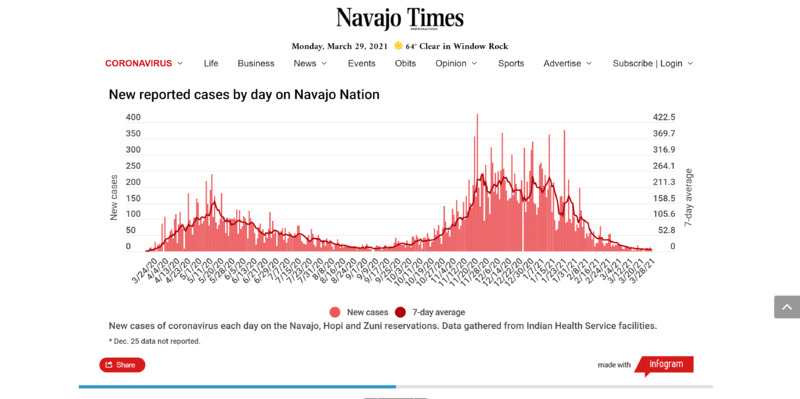
2021-03-29
In numbers: Tracking COVID-19 Across the Navajo Nation
By Navajo Times | Mar 29, 2021 | CORONAVIRUS |
On Sunday, Navajo Nation health officials reported 7 new COVID-19 cases. A total of 30,059 people have been sickened by the coronavirus.
The rate of decrease in new cases is slowing. Nevertheless, the seven day average is 7 new cases per day, a decrease of 30 percent from the average two weeks earlier.
On a per-capita basis, about 3 cases for every 100,000 people on the Navajo Nation are active. This means the Navajo Nation has the lowest per-capita cases anywhere in the 50 U.S. states.
No new deaths were announced, leaving the total at 1,246 casualties of the virus. At least 16,342 people on the Navajo Nation have recovered.
More than 8 of 10 people on the Navajo Nation have received at least one dose of the vaccine, or 86.3 percent of the population as of March 26, according to the Navajo Area Indian Health Service. A spokesperson for the Navajo Area IHS says 244,209 people get health care from it. Of those, 196,902 have received at least their first dose of a COVID-19 vaccine. That number includes 88,891 people, or 36.4 percent, who are fully vaccinated, according to the spokesperson.
Caution is still warranted: Highly contagious variants of the virus continue to spread. The more lethal U.K. variant is doubling every 10 days throughout the United States. It now represents more than half of new U.S. cases. Many jurisdictions near the Navajo Nation are relaxing COVID restrictions. Some health experts warn that easing up right now is too soon. It could lead to an increase in new cases.
Health experts recommend continued vigilance in wearing masks, social distancing, avoiding socializing with people outside your immediate household, and hand-washing. Double-masking also is recommended.
For those who are fully vaccinated, the CDC still recommends wearing a mask and hand-washing; although social restrictions are more relaxed. Follow this link for complete CDC guidance for those who are vaccinated: https://www.cdc.gov/coronavirus/2019-ncov/vaccines/fully-vaccinated.html
Although the Navajo Nation has relaxed some restrictions, a daily curfew remains in efffect from 10 p.m. to 5 a.m. Businesses may remain open until 9 p.m.
timeline
Positive Test Rate
The estimated percentage of people who tested positive was 1.2 percent on Sunday. The 7-day average positive test rate was estimated at 1.9 percent.
The World Health Organization recommends a 7-day average positive test rate of less than 10 percent for two weeks in a row. Localities that have a test rate of 3 percent or less are most successful in containing COVID-19, according to the WHO.
At Hopi, one new cases was reported overnight, bringing the total to 1,376. The Hopi radio station reported on its Facebook page that at least 120 people have died since the pandemic began last year, but the Hopi Tribe has not consistently reported fatalities from the virus.
The following charts and maps show the extent and location of the coronavirus on and near the Navajo Nation. Hover over, tap or click the map markers and graph for expanded information.
(Last updated March 29, 2021 at 10:44 a.m. MDT.)
Growth of COVID-19 on Navajo Nation and Hopi Reservation
Cases
April 2020
June 2020
August 2020
October 2020
December 2020
February 2021
0
10,000
20,000
30,000
40,000
Number
Date Cases
Mar 16, 2020 2
Mar 18, 2020 3
Mar 20, 2020 14
Mar 21, 2020 26
Mar 23, 2020 29
Mar 24, 2020 39
Mar 25, 2020 69
Mar 26, 2020 71
Mar 27, 2020 92
Mar 28, 2020 115
Mar 29, 2020 128
Apr 1, 2020 214
Apr 2, 2020 214
Apr 4, 2020 321
Apr 5, 2020 354
Apr 6, 2020 384
Apr 7, 2020 426
Apr 8, 2020 488
Apr 9, 2020 558
Apr 10, 2020 597
Apr 11, 2020 698
Apr 13, 2020 813
Apr 14, 2020 838
Apr 15, 2020 921
Apr 16, 2020 1,042
Apr 17, 2020 1,127
Apr 18, 2020 1,197
Apr 20, 2020 1,206
Apr 22, 2020 1,282
Apr 23, 2020 1,360
Apr 24, 2020 1,540
Apr 25, 2020 1,637
Apr 26, 2020 1,716
Apr 27, 2020 1,769
Apr 28, 2020 1,873
Apr 29, 2020 1,977
Apr 30, 2020 2,141
May 1, 2020 2,292
May 2, 2020 2,373
May 4, 2020 2,474
May 5, 2020 2,559
May 6, 2020 2,654
May 7, 2020 2,757
May 9, 2020 2,976
May 10, 2020 3,122
May 11, 2020 3,202
May 13, 2020 3,392
May 14, 2020 3,632
May 15, 2020 3,740
May 16, 2020 3,912
May 17, 2020 4,002
May 18, 2020 4,071
May 19, 2020 4,153
May 20, 2020 4,253
May 21, 2020 4,434
May 22, 2020 4,529
May 23, 2020 4,633
May 24, 2020 4,689
May 25, 2020 4,794
May 26, 2020 4,842
May 27, 2020 4,944
May 28, 2020 5,044
May 29, 2020 5,145
May 30, 2020 5,250
May 31, 2020 5,348
Jun 1, 2020 5,479
Jun 2, 2020 5,533
Jun 3, 2020 5,661
Jun 4, 2020 5,730
Jun 5, 2020 5,808
Jun 6, 2020 5,918
Jun 7, 2020 6,020
Jun 8, 2020 6,110
Jun 9, 2020 6,150
Jun 10, 2020 6,275
Jun 11, 2020 6,378
Jun 12, 2020 6,470
Jun 13, 2020 6,554
Jun 14, 2020 6,611
Jun 15, 2020 6,633
Jun 16, 2020 6,672
Jun 17, 2020 6,747
Jun 18, 2020 6,832
Jun 19, 2020 6,894
Jun 20, 2020 6,963
Jun 21, 2020 6,990
Jun 22, 2020 7,045
Jun 23, 2020 7,088
Jun 24, 2020 7,157
Jun 25, 2020 7,278
Jun 26, 2020 7,320
Jun 27, 2020 7,414
Jun 28, 2020 7,469
Jun 29, 2020 7,532
Jun 30, 2020 7,549
Jul 1, 2020 7,613
Jul 2, 2020 7,669
Jul 3, 2020 7,733
Jul 4, 2020 7,804
Jul 5, 2020 7,840
Jul 6, 2020 7,914
Jul 7, 2020 7,941
Jul 8, 2020 7,981
Jul 9, 2020 8,042
Jul 10, 2020 8,098
Jul 11, 2020 8,124
Jul 12, 2020 8,187
Jul 13, 2020 8,243
Jul 14, 2020 8,290
Jul 15, 2020 8,370
Jul 16, 2020 8,486
Jul 17, 2020 8,536
Jul 18, 2020 8,568
Jul 19, 2020 8,593
Jul 20, 2020 8,617
Jul 21, 2020 8,639
Jul 22, 2020 8,684
Jul 23, 2020 8,734
Jul 24, 2020 8,768
Jul 25, 2020 8,837
Jul 26, 2020 8,891
Jul 27, 2020 8,912
Jul 28, 2020 8,927
Jul 29, 2020 8,968
Jul 30, 2020 9,019
Jul 31, 2020 9,055
Aug 1, 2020 9,068
Aug 2, 2020 9,103
Aug 3, 2020 9,139
Aug 4, 2020 9,156
Aug 5, 2020 9,195
Aug 6, 2020 9,223
Aug 7, 2020 9,257
Aug 8, 2020 9,293
Aug 9, 2020 9,308
Aug 10, 2020 9,315
Aug 11, 2020 9,334
Aug 12, 2020 9,356
Aug 13, 2020 9,394
Aug 14, 2020 9,412
Aug 15, 2020 9,423
Aug 16, 2020 9,447
Aug 17, 2020 9,469
Aug 18, 2020 9,486
Aug 19, 2020 9,500
Aug 20, 2020 9,519
Aug 21, 2020 9,531
Aug 22, 2020 9,545
Aug 23, 2020 9,547
Aug 24, 2020 9,557
Aug 25, 2020 9,573
Aug 26, 2020 9,597
Aug 27, 2020 9,601
Aug 28, 2020 9,780
Aug 29, 2020 9,789
Aug 30, 2020 9,800
Aug 31, 2020 9,820
Sep 1, 2020 9,830
Sep 2, 2020 9,847
Sep 3, 2020 9,871
Sep 4, 2020 9,883
Sep 5, 2020 9,891
Sep 6, 2020 9,900
Sep 7, 2020 9,901
Sep 8, 2020 9,903
Sep 9, 2020 9,915
Sep 10, 2020 9,933
Sep 11, 2020 9,952
Sep 12, 2020 9,969
Sep 13, 2020 9,977
Sep 14, 2020 9,982
Sep 15, 2020 9,992
Sep 16, 2020 10,059
Sep 17, 2020 10,083
Sep 18, 2020 10,090
Sep 19, 2020 10,107
Sep 20, 2020 10,119
Sep 21, 2020 10,131
Sep 22, 2020 10,141
Sep 23, 2020 10,167
Sep 24, 2020 10,212
Sep 25, 2020 10,237
Sep 26, 2020 10,269
Sep 27, 2020 10,290
Sep 28, 2020 10,312
Sep 29, 2020 10,333
Sep 30, 2020 10,355
Oct 1, 2020 10,369
Oct 2, 2020 10,404
Oct 3, 2020 10,421
Oct 4, 2020 10,441
Oct 5, 2020 10,454
Oct 6, 2020 10,501
Oct 7, 2020 10,546
Oct 8, 2020 10,582
Oct 9, 2020 10,632
Oct 10, 2020 10,675
Oct 11, 2020 10,696
Oct 12, 2020 10,728
Oct 13, 2020 10,737
Oct 14, 2020 10,780
Oct 15, 2020 10,819
Oct 16, 2020 10,857
Oct 17, 2020 10,913
Oct 18, 2020 10,955
Oct 19, 2020 10,969
Oct 20, 2020 10,999
Oct 21, 2020 11,030
Oct 22, 2020 11,101
Oct 23, 2020 11,151
Oct 24, 2020 11,217
Oct 25, 2020 11,298
Oct 26, 2020 11,362
Oct 27, 2020 11,386
Oct 28, 2020 11,462
Oct 29, 2020 11,603
Oct 30, 2020 11,694
Oct 31, 2020 11,753
Nov 1, 2020 11,828
Nov 2, 2020 11,875
Nov 3, 2020 11,947
Nov 4, 2020 12,080
Nov 5, 2020 12,195
Nov 6, 2020 12,288
Nov 7, 2020 12,447
Nov 8, 2020 12,571
Nov 9, 2020 12,641
Nov 10, 2020 12,720
Nov 11, 2020 12,818
Nov 12, 2020 12,971
Nov 13, 2020 13,069
Nov 14, 2020 13,249
Nov 15, 2020 13,373
Nov 16, 2020 13,596
Nov 17, 2020 13,744
Nov 18, 2020 13,880
Nov 19, 2020 14,085
Nov 20, 2020 14,441
Nov 21, 2020 14,612
Nov 22, 2020 15,039
Nov 23, 2020 15,236
Nov 24, 2020 15,374
Nov 25, 2020 15,616
Nov 26, 2020 15,862
Nov 27, 2020 15,954
Nov 28, 2020 16,223
Nov 29, 2020 16,427
Nov 30, 2020 16,595
Dec 1, 2020 16,711
Dec 2, 2020 17,035
Dec 3, 2020 17,310
Dec 4, 2020 17,495
Dec 5, 2020 17,738
Dec 6, 2020 17,915
Dec 7, 2020 18,163
Dec 8, 2020 18,324
Dec 9, 2020 18,575
Dec 10, 2020 18,943
Dec 11, 2020 19,199
Dec 12, 2020 19,420
Dec 13, 2020 19,608
Dec 14, 2020 19,766
Dec 15, 2020 19,929
Dec 16, 2020 20,095
Dec 17, 2020 20,395
Dec 18, 2020 20,569
Dec 19, 2020 20,810
Dec 20, 2020 21,019
Dec 21, 2020 21,177
Dec 22, 2020 21,327
Dec 23, 2020 21,513
Dec 24, 2020 21,833
Dec 25, 2020 21,833
Dec 26, 2020 22,155
Dec 27, 2020 22,155
Dec 28, 2020 22,371
Dec 29, 2020 22,526
Dec 30, 2020 22,776
Dec 31, 2020 23,090
Jan 1, 2021 23,429
Jan 2, 2021 23,581
Jan 3, 2021 23,728
Jan 4, 2021 23,841
Jan 5, 2021 23,978
Jan 6, 2021 24,247
Jan 7, 2021 24,521
Jan 8, 2021 24,776
Jan 9, 2021 24,979
Jan 10, 2021 25,216
Jan 11, 2021 25,383
Jan 12, 2021 25,383
Jan 13, 2021 25,746
Jan 14, 2021 25,952
Jan 15, 2021 26,073
Jan 16, 2021 26,287
Jan 17, 2021 26,383
Jan 18, 2021 26,448
Jan 19, 2021 26,517
Jan 20, 2021 26,612
Jan 21, 2021 26,782
Jan 22, 2021 26,955
Jan 23, 2021 27,109
Jan 24, 2021 27,484
Jan 25, 2021 27,573
Jan 26, 2021 27,665
Jan 27, 2021 27,887
Jan 28, 2021 27,987
Jan 29, 2021 28,075
Jan 30, 2021 28,217
Jan 31, 2021 28,325
Feb 1, 2021 28,388
Feb 2, 2021 28,471
Feb 3, 2021 28,544
Feb 4, 2021 28,668
Feb 5, 2021 28,796
Feb 6, 2021 28,872
Feb 7, 2021 28,897
Feb 8, 2021 28,937
Feb 9, 2021 28,994
Feb 10, 2021 29,041
Feb 11, 2021 29,098
Feb 12, 2021 29,167
Feb 13, 2021 29,205
Feb 14, 2021 29,269
Feb 15, 2021 29,283
Feb 16, 2021 29,308
Feb 17, 2021 29,336
Feb 18, 2021 29,386
Feb 19, 2021 29,464
Feb 20, 2021 29,509
Feb 21, 2021 29,535
Feb 22, 2021 29,551
Feb 23, 2021 29,576
Feb 24, 2021 29,602
Feb 25, 2021 29,655
Feb 26, 2021 29,710
Feb 27, 2021 29,719
Feb 28, 2021 29,740
Mar 1, 2021 29,754
Mar 2, 2021 29,774
Mar 3, 2021 29,794
Mar 4, 2021 29,816
Mar 5, 2021 29,838
Mar 6, 2021 29,857
Mar 7, 2021 29,866
Mar 8, 2021 29,873
Mar 9, 2021 29,887
Mar 10, 2021 29,900
Mar 11, 2021 29,911
Mar 12, 2021 29,930
Mar 13, 2021 29,945
Mar 14, 2021 29,948
Mar 15, 2021 29,954
Mar 16, 2021 29,957
Mar 17, 2021 29,968
Mar 18, 2021 29,987
Mar 19, 2021 29,992
Mar 20, 2021 29,998
Mar 21, 2021 30,007
Mar 22, 2021 30,007
Mar 23, 2021 30,010
Print
COVID-19 Cases on the Navajo Reservation
Presumptive Positive
Tested Positive
Died
Recovered
0
5000
10000
15000
20000
25000
30000
Navajo Nation
Chinle AZ IHS
Tuba City Regional Health
Care
Shiprock NM IHS
Gallup NM IHS
Fort Defiance NM IHS
Crownpoint NM IHS
Kayenta AZ IHS
Winslow IHS
Zuni reservation
Hopi reservation
Utah Navajo Health System
Number of cases
Community Presumptive Positive Tested Positive Died Recovered
Navajo Nation 0 12483 1205 16,212
Chinle AZ IHS 5496 0 0
Tuba City Regional Health Care 6 5324 0 0
Shiprock NM IHS 0 5018 0 0
Gallup NM IHS 0 4729 0 0
Fort Defiance NM IHS 0 3562 0 0
Crownpoint NM IHS 0 2861 0 0
Kayenta AZ IHS 0 2642 0 0
Winslow IHS 0 1948 0 0
Zuni reservation 0 1454 0 0
Hopi reservation 0 1372 120 0
Utah Navajo Health System 0 1064 0 0
NOTE: Navajo Nation officials have been reconciling discrepancies for July and August data. At the end of August, in a press release, the president’s office added 165 cases that occurred between April 6 and Aug. 12. Then, on Sept. 8, they added 2 more cases for July. Health officials also added 16 more deaths to the overall tally at the beginning of September. According to a news release, the deaths occurred between May and August. Officials blamed several states for delayed results. On Sept. 16, officials added 49 previously unreported cases in New Mexico.
-

2021-03-16
Staff Reports
SAFFORD – The Graham County Department of Health and Human Services has announced that starting Monday, March 22, any resident of Graham County who is 18 years old or older will be eligible to receive a vaccine for COVID-19.
Those who would like a COVID-19 vaccination should contact their primary care physician or schedule an appointment with the health department by clicking here.
Those who schedule appointments will currently be given the two-shot Moderna vaccine at the Graham County Health Department Vaccination Center at 627 W. Main Street in Downtown Safford.
The health department will announce a clinic for the one-shot Johnson and Johnson vaccine at a later date.
While the Pfizer and Moderna two-shot vaccines utilize messenger RNA, the Johnson & Johnson vaccine works through a different mechanism and uses the more traditional DNA, which is introduced to the nucleus of cells with an adenovirus which is modified so it cannot replicate itself and cause disease. All three vaccines have been approved for use by the federal government and have safety records in good standing. All prompt the body to produce T-cells, which retain a memory of the protein and attack it.
“We would like to thank everyone for their support as we have navigated through the COVID-19 pandemic this past year,” said Graham County Health Department Director Brian Douglas.
Greenlee County
Gila Health Resources in Greenlee County will hold a COVID-19 vaccine drive at the Morenci Club Hall at 314 Plaza Dr. in Morenci on Friday, March 19, from 1 – 8 p.m.
At the vaccine drive, any adult resident of Greenlee County or those who work in Greenlee County can show up to receive a dose of the Moderna vaccine with no appointment or registration necessary.
-
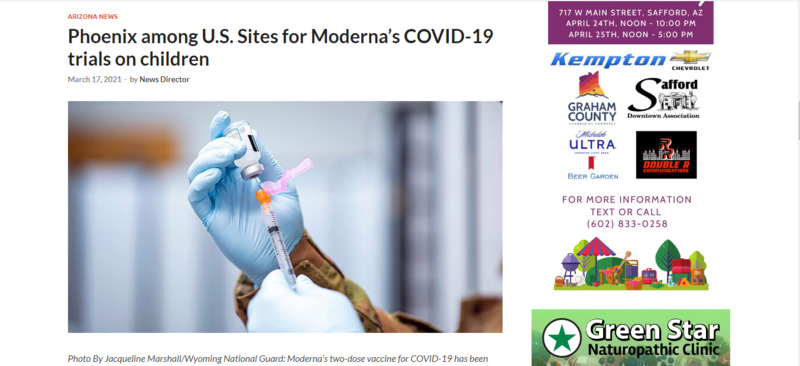
2021-03-17
By Jacob Holter/Cronkite News
WASHINGTON D.C. – Children from 6 months up to 12 years old could soon start getting the COVID-19 vaccine in Phoenix as part of a trial of the drug’s effectiveness on young people.
Drug-maker Moderna announced this week that Phoenix will be one of the cities where it will test smaller doses of its COVID-19 vaccine, which has currently only been approved for adult use, on preteens. The company has already started trials of the vaccine on teenagers.
While children have proven to be less susceptible to the disease, health experts say it’s important to have the option of a vaccine for younger kids as schools reopen and to improve the odds of “herd immunity” for the overall population.
“The reason we want to make sure that all of these kids get vaccinated is so we can truly achieve herd immunity. We don’t want to have little pockets of people who might be infectious and not be protected,” said Dr. Georges C. Benjamin, director of the American Public Health Association.
The preteen trials were announced Tuesday by Moderna, one of three pharmaceutical companies with vaccines approved for emergency use in adults in the U.S., along with Pfizer-BioNTech and Johnson & Johnson. Moderna and Pfizer vaccines require two doses, while the newer Johnson & Johnson vaccine has a one-dose protocol.
The announcement came the same day that the Arizona Department of Health Services announced that just over 1 million Arizonans have been fully vaccinated against the coronavirus. Overall, the state has administered about 2.6 million doses to a little more than 1.6 million people.
Moderna CEO Stéphane Bancel said in a statement that more than 53 million doses of his company’s version of the vaccine have been administered in the U.S., but “this pediatric study will help us assess the potential safety and immunogenicity of our COVID-19 vaccine candidate in this important younger age population.” The statement said the new trials would take place in the U.S. and Canada.
Dr. Steven Plimpton, the lead investigator for the Phoenix trial, said Tuesday that his office has “already gotten hundreds of calls” from parents interested in getting their children into the trial. He said parents interested in the trial in Phoenix can go to the KidCOVE site for more information or can call 602-368-1928 or 866-913-5454.
One University of Arizona expert said it will likely take a little while to get the trials in motion.
“I would say sometime in the next several weeks, as they get recruitment on board and they have a critical mass to start with and they have all of the aspects of the trial set up in terms of location, staffing, and everything that they need in place,” said Dr. Shad Marvasti, director of public health and prevention at the University of Arizona College of Medicine.
Moderna said that children in the first phase of the trial will receive doses of 25, 50, or 100 micrograms of the vaccine – an adult dose is 100 – depending on their age. Results from that phase will be used to determine dosages in a second phase when come subjects will get a placebo.
ad1
Ultimately, Moderna expects to include 6,750 children in the latest trials.
“The adult dose for the Moderna is 100 micrograms, but they are starting with 25 micrograms and then basically watching folks and kids to see how they react,” Marvasti said. “If that looks good and there are no major issues, then they will have a group of kids in the study with 50 micrograms and then if that looks okay they will have another group that has 100 micrograms.”
He added that Moderna’s trust that the vaccine is safe enough to begin trials on kids could have the added benefit of helping to quell vaccine hesitancy among others.
“Hopefully, depending on the results, it will help give people more confidence to get the vaccine, especially if it proves to be as safe and effective in children as it has been in adults,” Marvasti said.
The announcement of the preteen trials also comes as the state has ordered schools to begin to resume in-person schooling, after a year in which most students have attended class virtually.
Benjamin said that with schools reopening, in Arizona and across the U.S., a vaccine for youth would make a definite difference in controlling the virus, as it would prevent kids from spreading it to each other and then bringing it home with them. Vaccination would also expedite kids’ ability to return to normal.
“Getting kids vaccinated, I think, will certainly improve their quality of life and their ability to effectively interact with their friends,” he said.
-

2021-03-21
March 22, 2021 - by News Director
Contributed Article
SAN CARLOS – The San Carlos Apache Healthcare Corporation is proud to present a COVID-19 vaccine drive-through clinic for SCAT members and their family and friends of the surrounding communities of Globe, Miami, Superior, Hayden, Winkleman, Kearny, Pima, Thatcher, Safford, and Morenci.
Our SCAHC Vaccination team will be administering the Pfizer and Moderna vaccine at the San Carlos High School, on Saturday, March 27, from 8 a.m. – 4 p.m. No appointment is necessary.
For the Pfizer vaccine, those receiving it must be 16 years of age or older (must have a parent/legal guardian consent if under 18)
For the Moderna vaccine, those receiving it must be 18 years of age or older.
Please remember to bring your state ID. There is no charge for the vaccine.
-
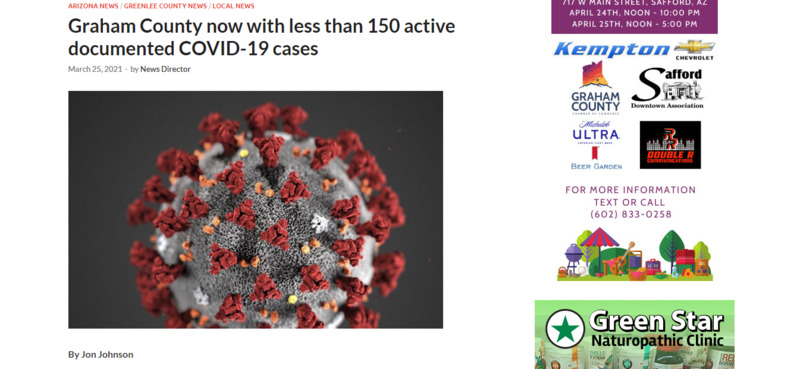
2021-03-25
By Jon Johnson
jonjohnsonnews@gmail.com
SAFFORD – Graham County has had very few new confirmed cases of COVID-19 in the past month, lowering its numbers to just 147 active cases as of Thursday.
According to the Graham County Department of Health and Human Services, Graham County has had a total of 5,355 confirmed cases for the course of the pandemic, with 5,132 listed as being recovered, 147 active, and 76 deaths in more than a year.
No new cases were recorded Thursday, and, according to the Arizona Department of Health Services COVID-19 school dashboard, Graham County had just a 1 percent positivity rate as of the week of March 14. That is good for a tie with Apache County for the second-lowest percent positivity rate out of Arizona’s 15 counties. Only Greenlee County, which registered a zero percent positivity rate from Feb. 27 – March 14, had lower.
With the lower cases statewide and vaccine rollout, Governor Doug Ducey issued an Executive Order on Thursday, rolling back several COVID-19 mitigation measures involving businesses and gatherings. This comes as other states roll back their COVID-19 mitigation measures as well.
The rollout of the various COVID-19 vaccines has picked up steam in the last month, with the state opening up the vaccine to anyone 16 years old or older for the Pfizer vaccine. Anyone 18 years old or older can be administered the Moderna and Johnson & Johnson vaccines. The San Carlos Apache Healthcare Corporation is holding a free, drive-through vaccine clinic on Saturday, March 27 at the San Carlos High School. No appointment is necessary. The clinic will be administering both the Pfizer and Moderna vaccines.
Graham County and Greenlee County are also providing vaccination sites for those 18 and older, and provide the Moderna and Johnson & Johnson vaccines.
Greenlee County
According to the Greenlee County Health Department, the county currently has just nine active cases of COVID-19.
For the course of the pandemic, Greenlee County has had 568 confirmed positive cases (by far the lowest out of any of Arizona’s 15 counties), with 549 recovered cases, nine active, and 10 deaths.
-

2021-03-28
By Lori Dugan/EAC
THATCHER — Eastern Arizona College’s Fine Arts Division proudly presents “You’re a Good Man, Charlie Brown” from April 7 – 10 at 7:30 p.m. in the Fine Arts Auditorium, with the understudy performance taking place on April 8.
General admission tickets are $5 for adults and are on sale now at the EAC Ticket Office. Call (928) 428-8228 for more information. EAC employees and students can attend for free.
Due to COVID-19, social distancing is in place to accommodate safe spacing. Masks are required.
You’re a Good Man, Charlie Brown synopsis
The musical, based on the wildly popular Peanuts comic strip by Charles Schulz, is probably best described as an average day in the life of Charlie Brown. It is made up of little moments, from Valentine’s Day to baseball season, from wild optimism to utter despair. The familiar cast of characters is there, from Lucy and Linus to Schroeder, Sally, and, of course, Snoopy.
The production explores what it means to be a good person, prompted by affirmations from Charlie Brown’s friends. These compliments set Charlie Brown on a journey of self-discovery as the audience follows him and his friends through a day of adventure and trials.
Musical numbers include “My Blanket and Me,” “The Kite,” “The Baseball Game,” “Little Known Facts,” “Suppertime,” and “Happiness.”
The play spans the months between Valentine’s Day and Beethoven Day, following the characters in their optimism and utter despair.
“’You’re a Good Man, Charlie Brown’ is a crowd-pleasing classic for all ages,” said Chase Moore, EAC Musical Theatre director. “Anybody who’s a Peanuts fan will relive lots of fun memories from the comic strip.”
Behind the production
The production is directed by Dr. Dale J. Young, and features set designs by Greg Owen, both EAC associate professors of theater arts. Music is under the direction of Chase Moore. The production is choreographed by Rena De La Cruz, with costumes designed by Timilee McNair.
Clark Gesner created the book, music, and lyrics for “You’re a Good Man, Charlie Brown”, with additional dialogue by Michael Mayer and additional music and lyrics by Andrew Lippa.
Winner of two Tony Awards, five Drama Desk Awards, and an Outer Critic Circle Award, this production’s musing on life’s ironies and delights continues to resonate with audiences’ hearts.
Theatre Arts at EAC
You can shine in the spotlight at EAC! In the Department of Theatre Arts, students take part in dynamic shows and emerge as artists for the next step in their careers.
“Our graduates are successful all across the country,” said Dr. Dale J. Young. “Some of the roles they hold are teachers, managers, actors, playwrights, directors, administrators, MFA graduate students, and the list goes on.”
Students interested in this area of study at Eastern Arizona College enter the Associate of Arts Program in Theatre Arts www.eac.edu/Academics/Programs_of_Study/Theatre/. This program offers dynamic learning opportunities in acting, stagecraft, scene design, stage make-up, costume design, play analysis, and more. This curriculum meets the targeted requirements for the first two years of a bachelor’s degree program at a college or university.
-
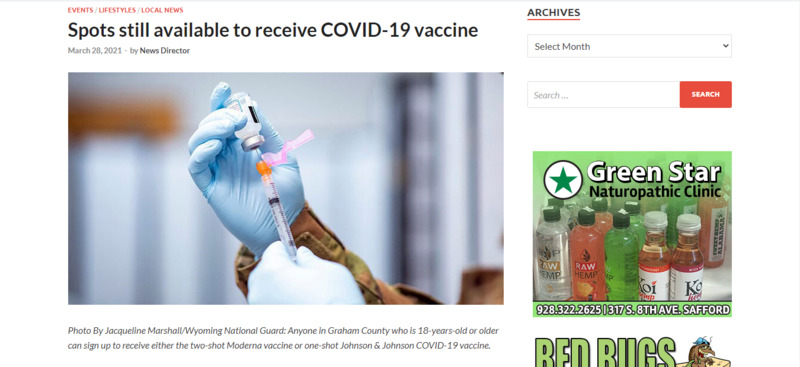
2021-03-28
Staff Reports
SAFFORD – While some in other states attempt to bribe or lie their way to the front of the vaccine lines, that isn’t necessary for those in Arizona.
The state has opened its registration to receive a COVID-19 vaccine to anyone 16-years-old and up for the Pfizer vaccine, and anyone 18-years-old and up for the Moderna and Johnson & Johnson vaccines.
In Graham County, the Graham County Department of Health and Human Services has advised that there “are many appointments still available” to receive the Moderna vaccine.
Anyone 18-years-old and up may schedule an appointment at www.graham.az.gov.
The Graham County Health Department Vaccination Center is located in Downtown Safford at 627 W. Main St.
In addition to the Moderna vaccine, a vaccination clinic for the one-dose Johnson & Johnson vaccine is also available to any Graham County resident who is 18-years-old or older. A vaccination clinic for the Johnson & Johnson vaccine will be held Friday, April 16. Register for an appointment at www.graham.az.gov.
For any additional questions contact the Graham County Department of Health and Human Services at 928-428-0110.
-
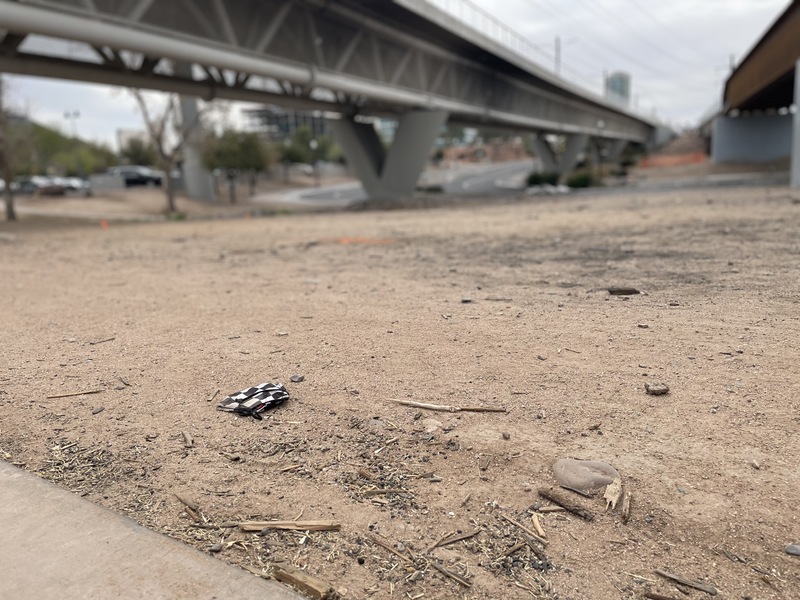
2021-03-26
Black and white checker fabric face mask near Tempe Beach park.
-
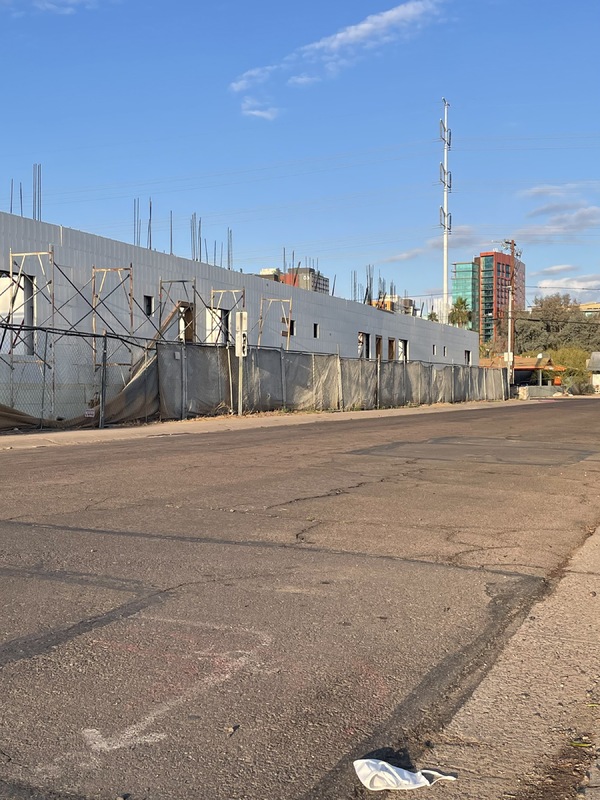
2021-03-26
Disposable white face mask found near 9th and Roosevelt in Tempe, AZ.
-
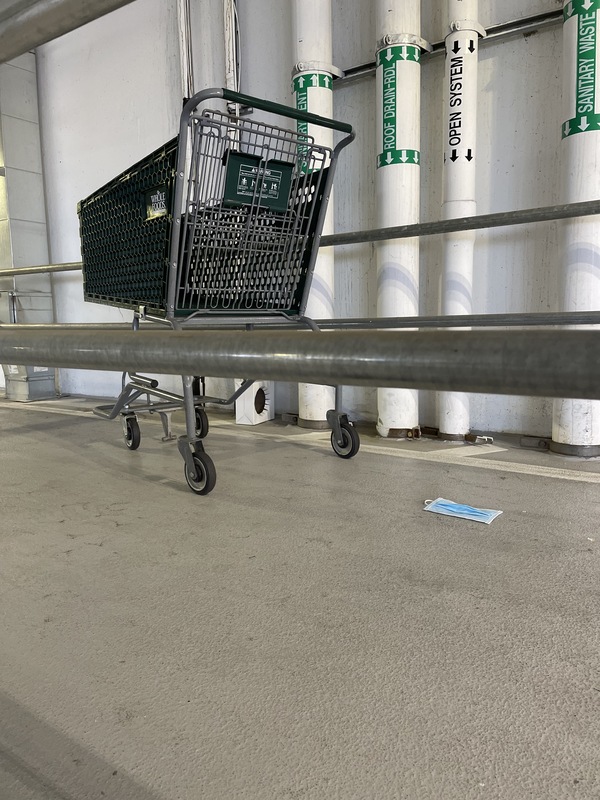
2021-03-27
Disposable mask on the ground near the cart return at Whole Foods in downtown Tempe, AZ.
-
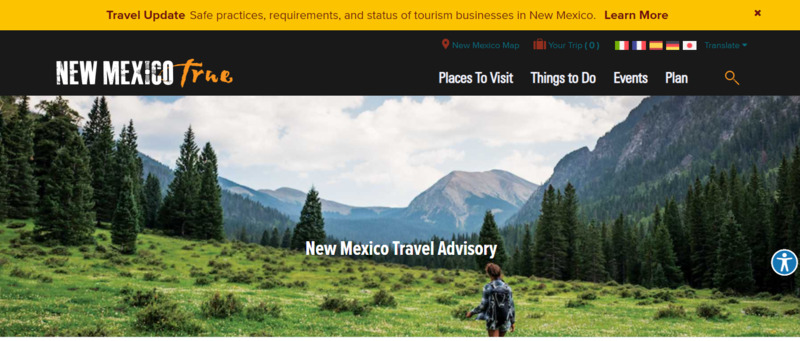
2021-02-11
Tips for Healthy & Safe Travel In New Mexico
During this time, the New Mexico business community is implementing additional COVID-Safe Practices at their establishments to help ensure the health and safety of their customers. Below are some of the additional safety measures you can expect and plan ahead for when visiting New Mexico’s businesses, restaurants, and attractions.
For more information on the status of COVID-19 in New Mexico, please visit the New Mexico Department of Health.
red alert
NOTICE FOR ALL TRAVELERS: Effective February 11, New Mexico will no longer require self-quarantine for visitors arriving into the state from "high-risk" states. Visitors from anywhere outside of the state will instead by strongly advised to self-quarantine for a period of 14 days and to seek out a COVID-19 test upon their arrival in or return to New Mexico.
NOTICE FOR ALL TRAVELERS: Face coverings are required for all visitors and residents in New Mexico. The only exceptions are when drinking, eating, or under medical instruction. Any individual found in violation may face a $100 fine.
Guidelines for Travel in New Mexico
If you are traveling to New Mexico, please follow all safety guidelines and restrictions. Local governments may impose more restrictive guidelines so be sure to check local instructions before traveling. Please be mindful of the following general guidelines for travel to and within the state of New Mexico:
Effective December 2, guidelines and restrictions in New Mexico have moved to a county-by-county basis. Please consult the county map from the New Mexico Department of Health to learn more about specific county restrictions
Effective February 11, New Mexico will no longer require self-quarantine for visitors arriving into the state from "high-risk" states. However, visitors from anywhere outside of the state are strongly advised to self-quarantine for 14 days and seek out a COVID-19 test upon their arrival in New Mexico
Everyone is required to wear a face covering in public in the state of New Mexico. The only exceptions to wearing a face covering are eating, drinking, or medical requirements.
Drive-in events may operate in accordance with COVID-Safe Practices.
Effective February 24, 2021, Casinos, Entertainment Venues, and Recreational Facilities may operate in accordance with COVID-Safe Practices within the county-by-county framework.
COVID-Safe New Practices at Hotels, Resorts & Lodging
Please note that guidelines and restrictions in New Mexico have moved to a county-by-county basis. Please consult the county map from the New Mexico Department of Health to learn more about lodging operations for specific counties. Please note these changes to hotel and lodging operations:
Lodging establishments will adhere to the enhanced cleaning procedures outlined by the American Hotel & Lodging Association’s Stay Safe Enhanced Industry-Wide Hotel Cleaning Standards.
Comfort items and appliances such as coffee machines, irons, hair dryers, extra blankets, etc. may be provided upon request.
Housekeeping shall only provide cleaning service during a guest’s stay upon request by the guest.
Multiple guests per room are to be limited to “same households” only (individuals who live within the same place of residence).
If food service is provided onsite, room service is encouraged as a first option for guests who would like food service with food carts being left at guest’s door to minimize contact.
Self-serve food bars and refreshments such as water, coffee, ice, etc. will be closed or removed. Hotel staff can provide these services upon request.
Valet service will be suspended.
Safe Dining
Please note that guidelines and restrictions in New Mexico have moved to a county-by-county basis. Please consult the county map from the New Mexico Department of Health to learn more about restaurant operating procedures for specific counties. Here are some of the COVID-Safe Practices and enhanced health and safety practices recommended by the Food and Drug Administration and the CDC that you can expect to be in place to keep customers safe while dining at New Mexico’s restaurants:
In an effort to support contact tracing, restaurants will be required to retain a daily log of all customers and employees who enter their establishment.
All customers are required to be screened for COVID-19 symptoms through a questionnaire upon entry of the premises.
Reservations, dining parties and private events may not exceed the mass gathering definition.
Reusable items such as menus and condiment containers left on tables will be cleaned and sanitized after each use. Items that cannot be cleaned and sanitized after each use will be replaced with single-use items.
Animals and pets, excluding service animals, will not be permitted inside the establishment, onto patios, into stores, or other such areas.
Responsible Outdoor Recreation
Effective February 24, 2021, New Mexico State Parks will be open for day use hours to all visitors. Effective February 27, camping will reopen to all visitors by reservation only. While many parks are reopening, services, activities, and hours of operations may be limited so please consult the current Conditions and Alerts page for each park.
Please be aware of the following safety and health guidelines currently in place:
Group sizes vary by county, so check the status of the county before traveling to a New Mexico State Park
Wearing a mask or cloth face covering is mandatory in public settings
Maintain a 6-foot distance between people
Visitors are strongly encouraged to carry their own sanitizing supplies and PPE
Comfort Stations and restrooms are closed to reduce close contact
Vault toilets at some State Parks will be available
Check with the National Park Service website for more information on openings, amenity availability, and best practices.
Safe Retail Shopping
Please note that guidelines and restrictions in New Mexico have moved to a county-by-county basis. Please consult the county map from the New Mexico Department of Health to learn more about retail operations for specific counties. Here are some of the safety guidelines required from New Mexico’s retailers to keep customers safe:
High-touch items such as doors, fitting rooms, and credit card terminals will be cleaned and disinfected once every two hours (or more frequently).
Safety protocols that allow for contactless curbside pickup and home delivery whenever possible will be established.
Signs, stanchions, and/or floor decals will be utilized wherever possible to support 6-foot social distancing, including one-way aisle traffic, and separate entry/exit.
COVID-Safe Practices for Museums and Cultural Sites
Museums with static displays may operate at limited occupancy in accordance with COVID-Safe Practices. Beginning February 4, state museums and historic sites may reopen under a modified framework. To learn more about the modified operations for state museums and historic sites, visit the Department of Cultural Affairs website.
Please contact individual museums and cultural institutions before planning your visit for additional information regarding openings, hours of operations, and available services. Here are some of the safety guidelines required to keep patrons safe:
Interactive exhibits and attractions will be discontinued.
Use of rental equipment, such as headsets, portable speakers, and strollers will be discontinued unless required for ADA accessibility.
Use of coat check areas, lockers, backpack and purse storage, and related storage for public use will be discontinued.
Safe Travel Recommendations
Outside of the modified 14-day self-quarantine requirement on certain travel to New Mexico (see above), there are currently no domestic travel restrictions to the state of New Mexico. However, visitors to New Mexico should continue to follow the protective measures outlined by the CDC:
Wash your hands often with soap and water for at least 20 seconds
If soap and water are not readily available, use a hand sanitizer that contains at least 60% alcohol
Avoid touching your eyes, nose, and mouth with unwashed hands
Put a distance of at least six feet between you and other people
Stay home if you are sick, except to get medical care
Stay up to date on the latest travel advisories from the CDC, WHO, and the U.S. Department of State
-
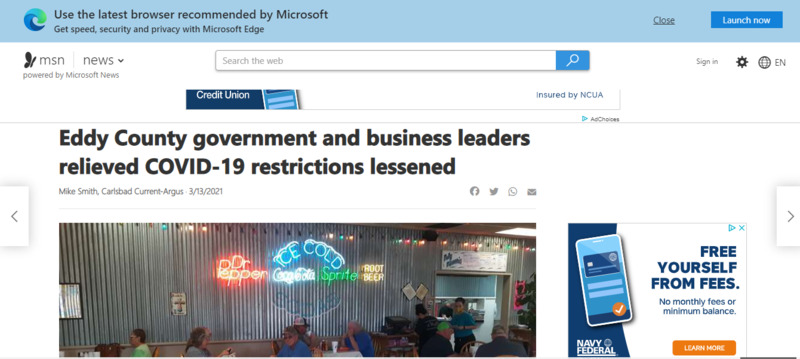
2021-03-13
This article discusses recent easing of the New Mexico state government's business restrictions in Eddy County. Businesses have been struggling to remain open and viable for the past year, and these lessened restrictions may help some restauranteurs avoid shuttering their businesses and permanently laying off their employees. The restrictions there, like many states, have specifically targeted the food and beverage industries while mega-stores are seldom impacted. During the previous year, the mid-sized community of Carlsbad lost 2 of its 3 grocery stores to temporary shutdown mandates over the holiday season. This community and its county have been especially hard-hit by economic impacts of President Biden's new Executive Orders on oil and gas production on federal lands, and the pandemic's additional business restrictions have made this a very difficult place to operate and patronize businesses.
-
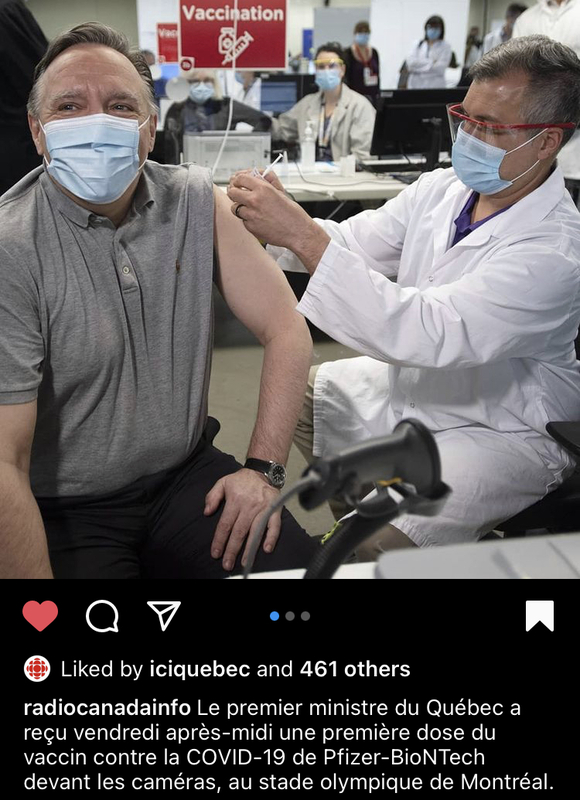
2021-03-26
He has received his first dose of the Pfizer Covid-19 vaccine at the Olympic stadium in Montreal.
-
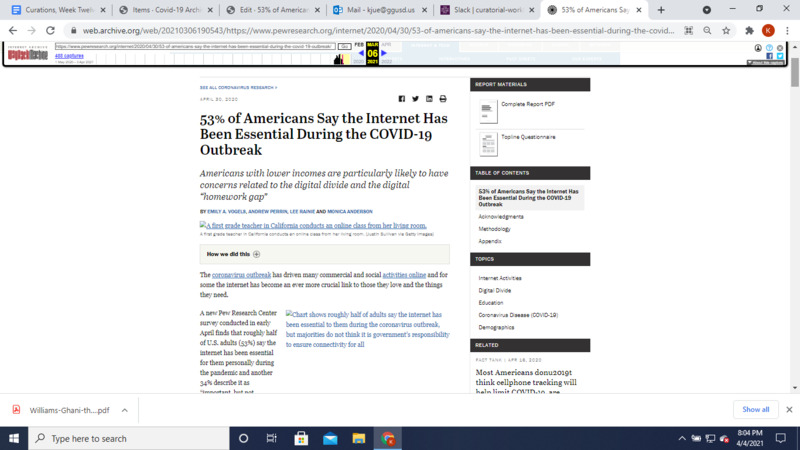
2020-04-30
This Pew Research article discusses how different socioeconomic status and political preference influences how Americans believe schools should provide technology for their students. More importantly, the article goes into detail about how parents with lower incomes are more likely to struggle to provide some sort of adequate situation for their children, especially when the majority of Americans view technology and the internet as an essential tool during the pandemic. Besides student access to technology, economic class is also having an impact on how some individuals can afford their own internet connections and phone plans, thereby limiting their access.
-
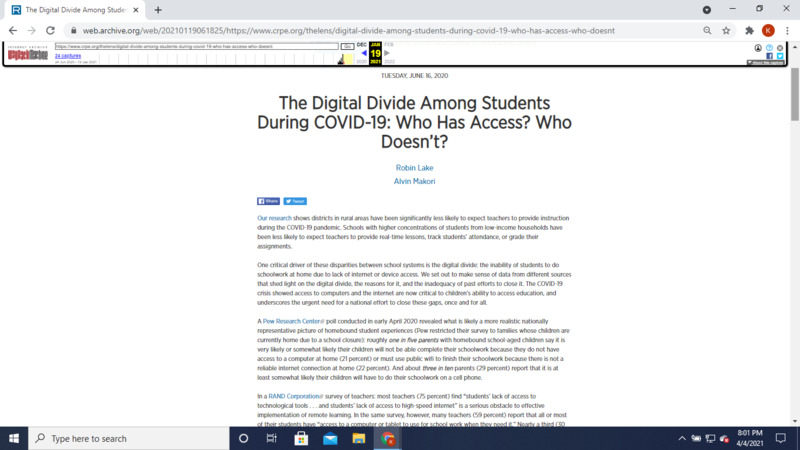
2020-06-16
The article goes into detail, drawing from multiple survey sources on the internet to discuss how geographical location and economic class has affected the way that some students have been able to adapt to online instruction. Sources like the Pew Research Center show information from parents about their children's access to technology and how it has affected their capacity to complete their schoolwork, and compares that information to different school districts' capabilities to provide reliable sources of internet/other technology during school shutdowns. The article concludes by questioning how public education is a right in the US, but due to access with technology, and even basic technological issues for those who already had access to sufficient technology, has questioned how America's students are struggling to gain what they should be ensured.
 2020-11-16
2020-11-16 2021-03-13
2021-03-13 2021-04-01
2021-04-01 2021-03-30
2021-03-30 2021-03-31
2021-03-31 2021-03-31
2021-03-31 2021-03-31
2021-03-31 2021-03-31
2021-03-31 2021-03-31
2021-03-31 2021-03-19
2021-03-19 2021-03-31
2021-03-31 2021-03-31
2021-03-31 2020-05-11
2020-05-11 2021-03-31
2021-03-31 2021-03-18
2021-03-18 2020-03-22
2020-03-22 2019
2019 2021-03-30
2021-03-30 2021-03-23
2021-03-23 2021-03-30
2021-03-30 2021-03-25
2021-03-25 2021-01-11
2021-01-11 2020-03-11
2020-03-11 2020-03-21
2020-03-21 2020-04-02
2020-04-02 2020-11-21
2020-11-21 2021-03-25
2021-03-25 2021-03-29
2021-03-29 2021-03-29
2021-03-29 2021-03-29
2021-03-29 2021-03-27
2021-03-27 2021-03-25
2021-03-25 2021-03-26
2021-03-26 2021-03-09
2021-03-09 2021-03-29
2021-03-29 2021-03-16
2021-03-16 2021-03-17
2021-03-17 2021-03-21
2021-03-21 2021-03-25
2021-03-25 2021-03-28
2021-03-28 2021-03-28
2021-03-28 2021-03-26
2021-03-26 2021-03-26
2021-03-26 2021-03-27
2021-03-27 2021-02-11
2021-02-11 2021-03-13
2021-03-13 2021-03-26
2021-03-26 2020-04-30
2020-04-30 2020-06-16
2020-06-16